![]()
Etienne Delessert, illustration for Stories 1, 2, 3, 4 by Ionesco
McSweeney's McMullens recently published—cause for celebration!—Stories 1, 2, 3, 4 by Eugene Ionesco and Etienne Delessert. (Get a copy from the publisher; Amazon.) The publisher explains: "Back in print for the first time since the 1970s, these illustrated stories by one of the twentieth century’s great playwrights make ideal bedtime reading for young children. The “silly” stories, as Ionesco called them, are accompanied by nearly 100 full-color illustrations. The art for Stories 1 & 2, first published in the 70s, was painstakingly restored by the artist. The art for stories 3 and 4 was newly made for this brand new "1234" compilation."
![]()
Etienne Delessert, illustration for Stories 1, 2, 3, 4 by Ionesco
Before getting to a short interview I did with Etienne Delessert (one of my favorite illustrators), I wanted to provide two fun sections from the book which I think could be published as stand-alone prose poems:
From Story #1"She had a mother who was named Mrs. Jacqueline. Her father was named Mr. Jacqueline. Little Jacqueline had two sisters who were both named Jacqueline, two boy cousins who were named Jacqueline, two girl cousins who were named Jacqueline, and an aunt and an uncle who were also named Jacqueline.
"The uncle and the aunt named Jacqueline had some friends named Mr. and Mrs. Jacqueline, who had a little girl named Jacqueline and a little boy named Jacqueline. The little girl had dolls, three dolls, named Jacqueline, Jacqueline, and Jacqueline."
From Story #2So Papa teaches Josette the real meaning of words. A chair is a window. The window is a fountain pen. A pillow is bread and bread is a bedside rug. Feet are ears, arms are feet. A head is a bottom. A bottom is a head. Eyes are fingers, fingers are eyes.
So Josette speaks the way her father teaches her. She says: "I look out the chair while eating my pillow, I open the wall, I walk with my ears. I have ten eyes to walk with and two fingers to look with. I put my head on the floor to sit down, I put my bottom on the ceiling. After eating the music box, I spread jam on the rug for a great dessert. Take the window, Papa, and draw me some pictures."
![]()
Etienne Delessert, illustration for Stories 1, 2, 3, 4 by Ionesco
Q & A with Etienne Delessert
50 Watts: Had you followed Ionesco's work before illustrating his children's stories? Were you surprised he had written children's stories?Delessert: I was born with Kafka, Beckett and Ionesco for friends. I remember seeing Waiting for Godot when I was 17: it not only changed my vision of theatre, it changed my way to tell a story.
Had you illustrated the original French-language editions?
Long saga: the original Stories 1 and 2 were initially published in 1968 and 1970 in New York, where I was living then, by a small, quirky publishing house headed by Harlin Quist.
Quist had a really original talent, and gave lots of freedom to the artists he had chosen. But he was also an eminent crook, and Eugène Ionesco and I decided not to work on the next two stories as we realized that we would never be paid. It took me 40 years to go back to his texts and finish the book. It was a great challenge to draw the same characters, to stage similar stories such a long time after completing the two first ones. But it worked!
It had been my own idea to ask to Quist to contact Ionesco in Paris. He had never written for children.
![]()
Etienne Delessert, illustration for Stories 1, 2, 3, 4 by Ionesco
Did you ever meet with Ionesco?We met after the first book came out, in New York. I remember going with him to see a doctor (he hated flying and needed pills to sleep on the plane) the day before he went back to France. From 42nd street to East 75th street we saw that day three cars burning, at three different locations: he was terrorized...
Later I met him several times at his place near La Coupole (in Story 3, I show part of his apartment). Years later he spent 10 days in Switzerland with me to prepare a long interview on film. Any reference to his plays would have been presented in animation. The film, produced by the Gallimard publishing house, was not completed. [Ed. note: Damn.]
![]()
Etienne Delessert, illustration for Stories 1, 2, 3, 4 by Ionesco
Did you get to discuss your illustrations with Ionesco, either before or after publication? No discussion before the books were published; at first he was surprised by my interpretations, then he understood that we were on the same wave length. The two books were very well received in seven languages, and reprinted often. But we never saw any royalties.
Instead of cleaning his act, Quist prefered to break our contract and ask two French artists to illustrate the two remaining texts. These mediocre interpretations disappeared quickly. So the Gallimard and McSweeney's editions are, finally, offering the original vision of the authors. We have five coeditions to date, including a large one in China.
![]()
Etienne Delessert, illustration for Stories 1, 2, 3, 4 by Ionesco
How was the project received by readers and critics when first published?
I was amazed, 40 years later, to see the difference in the way some people perceived the stories. Back then we heard questions about what a real children's book should be. Same concern as for the Wild Things of Sendak.
But these are simple stories that a father is inventing for his daughter. And Ionesco was a very talented father... It was home theater and his daughter Marie-France had some fine lines too.
Thanks for taking the time to answer these questions, Etienne!
![]()
Etienne Delessert, illustration for Stories 1, 2, 3, 4 by Ionesco
Bio of the illustrator:
Etienne Delessert was born in 1941 in Switzerland, and now lives in Lakeville, Connecticut, with his wife Rita Marshall and their son Adrien.
For more than thirty years this self-taught artist has been translating his—and the world's—ideas, passions, fantasies and nightmares into the visual language of books, magazine illustrations, posters, animated films, paintings and sculptures. He reaches both children and adults with his imaginary creatures and landscapes, juxtaposing the familiar with the fantastic to clarify this world and create new and lasting universes.
Delessert has illustrated more than eighty books, some translated in 14 languages, with millions of copies sold worldwide. From his groundbreaking The Endless Party, created in the 60's, along with his influential collaborations with Eugene Ionesco (Contes 1, 2, 3, 4) in French, and Jean Piaget (How The Mouse...), to his more recent award-winning A Long Long Song, Ashes Ashes, Dance!, The Seven Dwarfs, Who Killed Cock Robin?, Humpty Dumpty, Big and Bad, Full Color, Moon Theater and Spartacus the Spider. He is considered as one of the fathers of modern children's picture books.
Twice he was honored by the Premio Grafico of the Bologna World Children's Book Fair. His illustrations have appeared in leading magazines and newspapers such as The Atlantic Monthly, Le Monde and The New York Times. His animated films include the adventures of the endearing Yok-Yok and creations for Sesame Street.
He is the recipient of thirteen gold and twelve silver medals of the American Society of Illustrators as well as the 1996 Hamilton King Award, and recently a finalist for the 2010 Hans Christian Andersen Award.
![]()
Etienne Delessert, illustration for Stories 1, 2, 3, 4 by Ionesco
![]()
Etienne Delessert, illustration for Stories 1, 2, 3, 4 by Ionesco
![]()
Etienne Delessert, illustration for Stories 1, 2, 3, 4 by Ionesco
![]()
Etienne Delessert, illustration for Stories 1, 2, 3, 4 by Ionesco
![]()
Etienne Delessert, illustration for Stories 1, 2, 3, 4 by Ionesco
For more details about the publication history of this book, see a longer interview with Delessert on We Too Were Children.
But first buy the book!
![]() This is part of Knopf's attractive 1940s "Made in..." series for young adults. (Some seem to be illustrated with photographs, though most have drawings.) The mighty Mérida illustrated the Mexico volume, which is how I found the series. I imagine they won't be reprinted, but you could buy one for 92 cents.
Luckily the back cover has a full bio for the illustrators:M. S. Nowicki is a composite name representing Matthew Nowicki and his wife, Stanislawa. They worked together on the illustrations and jacket of this book. In Poland they received several prizes in both architectural and graphic competitions, and were awarded the Gold Medal at the International Paris Exposition of 1937.
Matthew Nowicki is head of the Department of Architecture at North Carolina State College of Agriculture and Engineering in Raleigh, and is on the staff of the United Nations as consultant to the director of planning of the United Nations buildings in New York.
Stanislawa is teaching graphic arts at the same college. They plan to make their permanent home in this country.
And the bio ends: "The illustrations for this book were designed to reflect the regional features of composition and detail characteristic of Polish peasant art."
Nowicki may be better known in Raleigh for his Dorton Arena.
This is part of Knopf's attractive 1940s "Made in..." series for young adults. (Some seem to be illustrated with photographs, though most have drawings.) The mighty Mérida illustrated the Mexico volume, which is how I found the series. I imagine they won't be reprinted, but you could buy one for 92 cents.
Luckily the back cover has a full bio for the illustrators:M. S. Nowicki is a composite name representing Matthew Nowicki and his wife, Stanislawa. They worked together on the illustrations and jacket of this book. In Poland they received several prizes in both architectural and graphic competitions, and were awarded the Gold Medal at the International Paris Exposition of 1937.
Matthew Nowicki is head of the Department of Architecture at North Carolina State College of Agriculture and Engineering in Raleigh, and is on the staff of the United Nations as consultant to the director of planning of the United Nations buildings in New York.
Stanislawa is teaching graphic arts at the same college. They plan to make their permanent home in this country.
And the bio ends: "The illustrations for this book were designed to reflect the regional features of composition and detail characteristic of Polish peasant art."
Nowicki may be better known in Raleigh for his Dorton Arena.
![]() Note: I blew-up most of these images so you can appreciate the details. The book is about 6 x 9.
Note: I blew-up most of these images so you can appreciate the details. The book is about 6 x 9.
![]()
![]()
![]()
![]()
![]()
![]()
![]()
![]()
![]()
![]()
![]()
![]()
![]()
![]()
![]()
![]()
![]()
![]()
![]()
![]()
![]()
![]()
![]() Note the maiden's incredible head.
Note the maiden's incredible head.
![]() My dust jacket is pretty trashed.
Previously: Stray and Idle Notions
See all posts tagged "Poland" on 50 Watts
My dust jacket is pretty trashed.
Previously: Stray and Idle Notions
See all posts tagged "Poland" on 50 Watts
 This is part of Knopf's attractive 1940s "Made in..." series for young adults. (Some seem to be illustrated with photographs, though most have drawings.) The mighty Mérida illustrated the Mexico volume, which is how I found the series. I imagine they won't be reprinted, but you could buy one for 92 cents.
Luckily the back cover has a full bio for the illustrators:M. S. Nowicki is a composite name representing Matthew Nowicki and his wife, Stanislawa. They worked together on the illustrations and jacket of this book. In Poland they received several prizes in both architectural and graphic competitions, and were awarded the Gold Medal at the International Paris Exposition of 1937.
Matthew Nowicki is head of the Department of Architecture at North Carolina State College of Agriculture and Engineering in Raleigh, and is on the staff of the United Nations as consultant to the director of planning of the United Nations buildings in New York.
Stanislawa is teaching graphic arts at the same college. They plan to make their permanent home in this country.
And the bio ends: "The illustrations for this book were designed to reflect the regional features of composition and detail characteristic of Polish peasant art."
Nowicki may be better known in Raleigh for his Dorton Arena.
This is part of Knopf's attractive 1940s "Made in..." series for young adults. (Some seem to be illustrated with photographs, though most have drawings.) The mighty Mérida illustrated the Mexico volume, which is how I found the series. I imagine they won't be reprinted, but you could buy one for 92 cents.
Luckily the back cover has a full bio for the illustrators:M. S. Nowicki is a composite name representing Matthew Nowicki and his wife, Stanislawa. They worked together on the illustrations and jacket of this book. In Poland they received several prizes in both architectural and graphic competitions, and were awarded the Gold Medal at the International Paris Exposition of 1937.
Matthew Nowicki is head of the Department of Architecture at North Carolina State College of Agriculture and Engineering in Raleigh, and is on the staff of the United Nations as consultant to the director of planning of the United Nations buildings in New York.
Stanislawa is teaching graphic arts at the same college. They plan to make their permanent home in this country.
And the bio ends: "The illustrations for this book were designed to reflect the regional features of composition and detail characteristic of Polish peasant art."
Nowicki may be better known in Raleigh for his Dorton Arena.
 Note: I blew-up most of these images so you can appreciate the details. The book is about 6 x 9.
Note: I blew-up most of these images so you can appreciate the details. The book is about 6 x 9.






















 Note the maiden's incredible head.
Note the maiden's incredible head.
 My dust jacket is pretty trashed.
Previously: Stray and Idle Notions
See all posts tagged "Poland" on 50 Watts
My dust jacket is pretty trashed.
Previously: Stray and Idle Notions
See all posts tagged "Poland" on 50 Watts
 Takayoshi Fukuda, circa 1981
Takayoshi Fukuda, circa 1981
 Hanmo Sugiuura, advertising poster, circa 1981
Hanmo Sugiuura, advertising poster, circa 1981

 Toshinobu Imai, magazine illustration, circa 1981
Toshinobu Imai, magazine illustration, circa 1981
 Hidetoshi Umeda, magazine illustration, circa 1981
Hidetoshi Umeda, magazine illustration, circa 1981
 Ryu Kumita, workbook, circa 1981
Ryu Kumita, workbook, circa 1981
 Shuhei Hasegawa, circa 1981
Shuhei Hasegawa, circa 1981
 Tsunemasa Takahashi, magazine illustration, 1980
Tsunemasa Takahashi, magazine illustration, 1980
 Tadami Yamada, late 70s
Tadami Yamada, late 70s
 Hidetoshi Umeda, magazine illustration, circa 1981
Hidetoshi Umeda, magazine illustration, circa 1981
 Shiro Tatsumi, early 70s
Shiro Tatsumi, early 70s
 Haruo Takino, early 70s
Haruo Takino, early 70s
 Toshinobu Imai, early 70s
Toshinobu Imai, early 70s
 Toshiichi Mamura, theater poster, circa 1981
Is that Neil Young?
Toshiichi Mamura, theater poster, circa 1981
Is that Neil Young?
 Shigeru Izumiya, magazine illustration, circa 1981
Shigeru Izumiya, magazine illustration, circa 1981
 Koji Numata, late 70s
Koji Numata, late 70s
 Shozo Shinoda, book illustration, circa 1981
Shozo Shinoda, book illustration, circa 1981
 Takashi Koizumi, book cover illustration, circa 1981
Takashi Koizumi, book cover illustration, circa 1981
 Natsuo Noma, magazine ad, circa 1981
Natsuo Noma, magazine ad, circa 1981
 Yukio Ueda, late 70s
Yukio Ueda, late 70s
 Jyosuke Kubo, late 70s
Jyosuke Kubo, late 70s
 Nanae Koiso, late 70s
Nanae Koiso, late 70s
 Keiichi Tanaami, exhibition poster, circa 1981
Previously: Space Teriyaki
Keiichi Tanaami, exhibition poster, circa 1981
Previously: Space Teriyaki
 For three years, Laura Ottina of the blog Animalarium has brought me joy with her weekly feature on Italian illustrator Franco Matticchio (b. 1957).
Repeating the intro from her inaugural post:I want to start this new blog about animals and artists with a post about a friend of mine who also happens to be one of my favorite Italian illustrators: Franco Matticchio. His drawings are witty, elegant and full of fantasy; sometimes dark, often enigmatic, always very personal. Animals are consistent inhabitants of Matticchio's unpredictable and humorous universe. Notably, an eyepatch-wearing cat called Jones is the protagonist of a series of surreal comics stories collected in the volume Sensa Senso, while a lonely bull terrier features in the animated title sequence for Roberto Benigni's movie "Il Mostro".
I asked Laura and Matticchio if I could feature some of these 150+ images, and to my delight Matticchio scanned even more of his work just for this post. Here are a bunch of my favorites.
For three years, Laura Ottina of the blog Animalarium has brought me joy with her weekly feature on Italian illustrator Franco Matticchio (b. 1957).
Repeating the intro from her inaugural post:I want to start this new blog about animals and artists with a post about a friend of mine who also happens to be one of my favorite Italian illustrators: Franco Matticchio. His drawings are witty, elegant and full of fantasy; sometimes dark, often enigmatic, always very personal. Animals are consistent inhabitants of Matticchio's unpredictable and humorous universe. Notably, an eyepatch-wearing cat called Jones is the protagonist of a series of surreal comics stories collected in the volume Sensa Senso, while a lonely bull terrier features in the animated title sequence for Roberto Benigni's movie "Il Mostro".
I asked Laura and Matticchio if I could feature some of these 150+ images, and to my delight Matticchio scanned even more of his work just for this post. Here are a bunch of my favorites.



















 The joys of blogging = something like this appearing in your inbox.
The joys of blogging = something like this appearing in your inbox.
 Kay Nielsen, illus. for Andersen's story "The Tinderbox" (see the original post) [Tinderbox!]
Though this is my first post on Danish-American illustrator Kay Nielsen (1886–1957), his influence can be seen everywhere on 50 Watts (try Lathrop and Sterrett).
Golden Age Comic Book Stories has done a great job of archiving Nielsen's work online—they made most of these scans. Calla Editions have reprinted East of the Sun and West of the Moon: Old Tales from the North and will soon reprint In Powder and Crinoline (wisely re-titled The Twelve Dancing Princesses).
Kay Nielsen, illus. for Andersen's story "The Tinderbox" (see the original post) [Tinderbox!]
Though this is my first post on Danish-American illustrator Kay Nielsen (1886–1957), his influence can be seen everywhere on 50 Watts (try Lathrop and Sterrett).
Golden Age Comic Book Stories has done a great job of archiving Nielsen's work online—they made most of these scans. Calla Editions have reprinted East of the Sun and West of the Moon: Old Tales from the North and will soon reprint In Powder and Crinoline (wisely re-titled The Twelve Dancing Princesses).
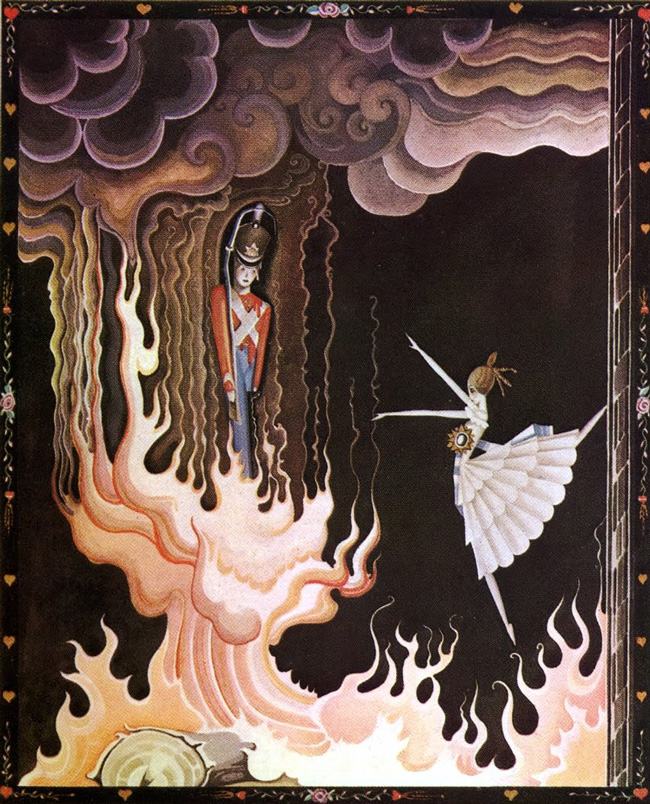 Andersen tale (see the original post)
Andersen tale (see the original post)
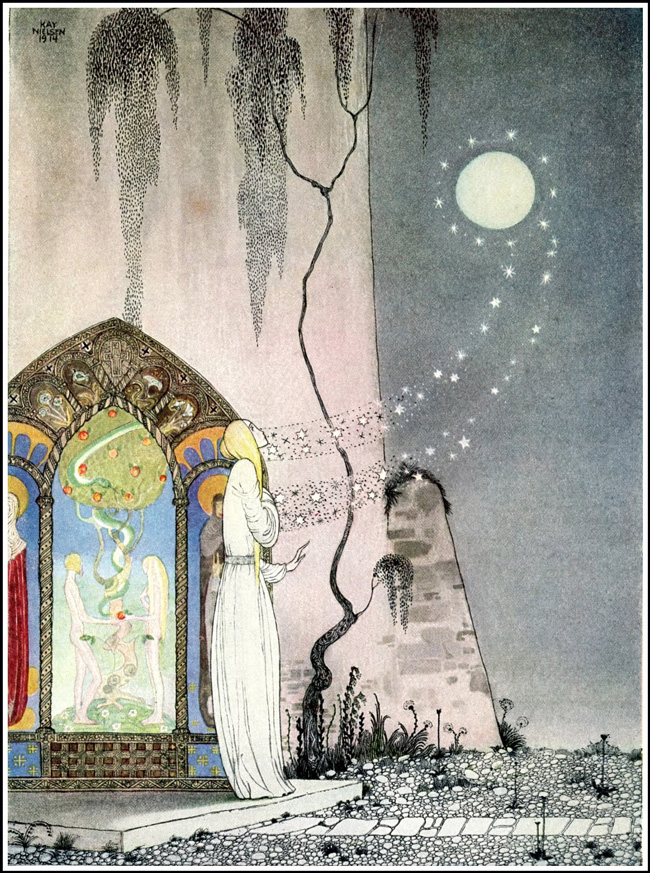 East of the Sun and West of the Moon, 1914 (see the original post)
East of the Sun and West of the Moon, 1914 (see the original post)
 East of the Sun and West of the Moon, 1914 (see the original post)
East of the Sun and West of the Moon, 1914 (see the original post)
 East of the Sun and West of the Moon, 1914 (see the original post)
East of the Sun and West of the Moon, 1914 (see the original post)
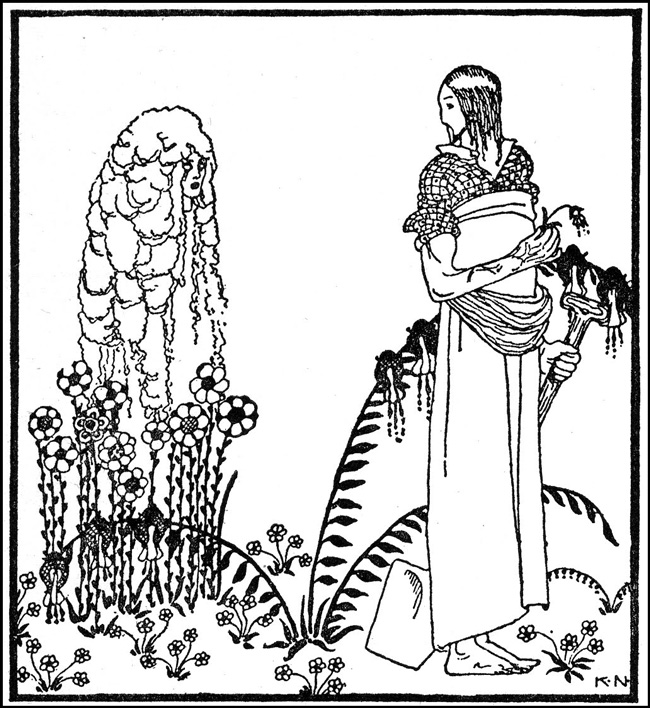 East of the Sun and West of the Moon, 1914 (see the original post)
East of the Sun and West of the Moon, 1914 (see the original post)
 East of the Sun and West of the Moon, 1914 (see the original post)
East of the Sun and West of the Moon, 1914 (see the original post)
 East of the Sun and West of the Moon, 1914 (see the original post)
East of the Sun and West of the Moon, 1914 (see the original post)
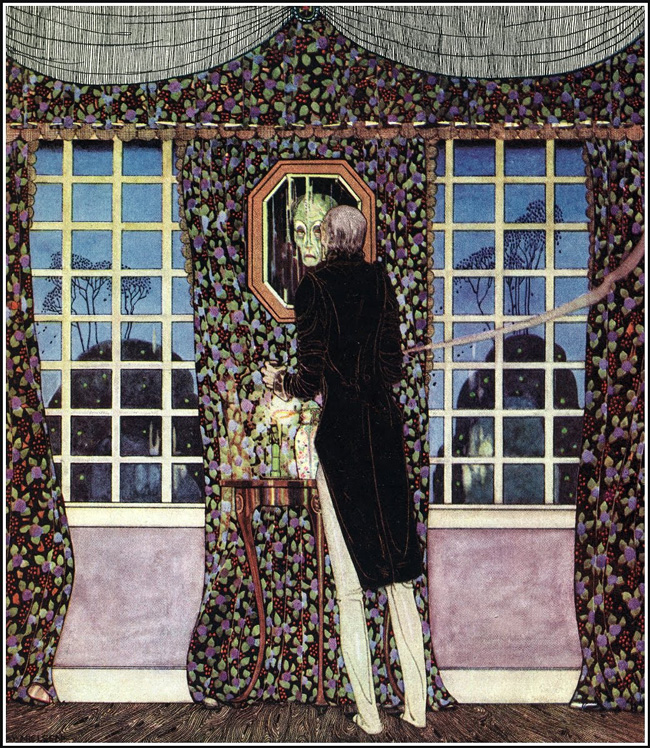 In Powder and Crinoline, 1912 (see the original post)
In Powder and Crinoline, 1912 (see the original post)
 In Powder and Crinoline, 1912 (see the original post)
In Powder and Crinoline, 1912 (see the original post)
 In Powder and Crinoline, 1912 (see the original post)
In Powder and Crinoline, 1912 (see the original post)
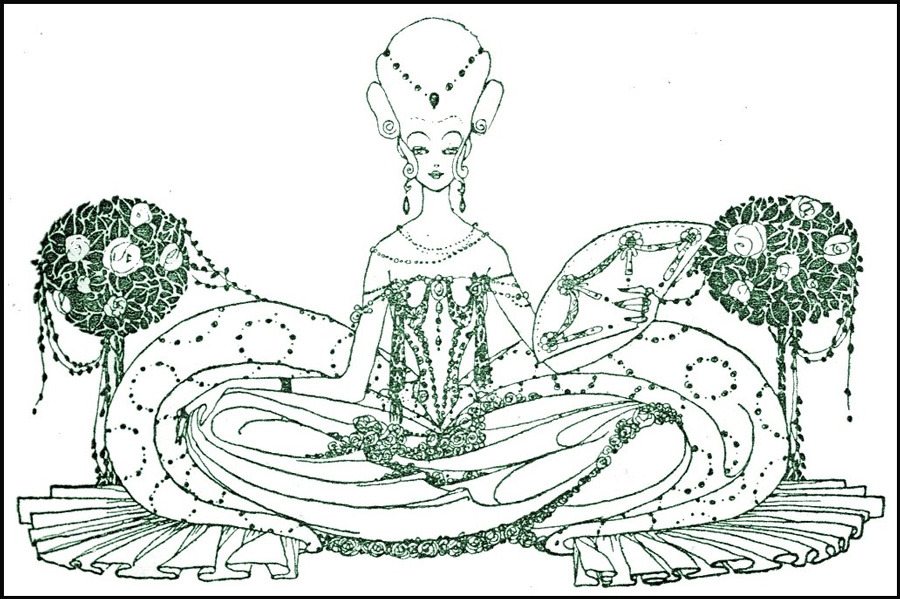 In Powder and Crinoline, 1912 (see the original post)
In Powder and Crinoline, 1912 (see the original post)
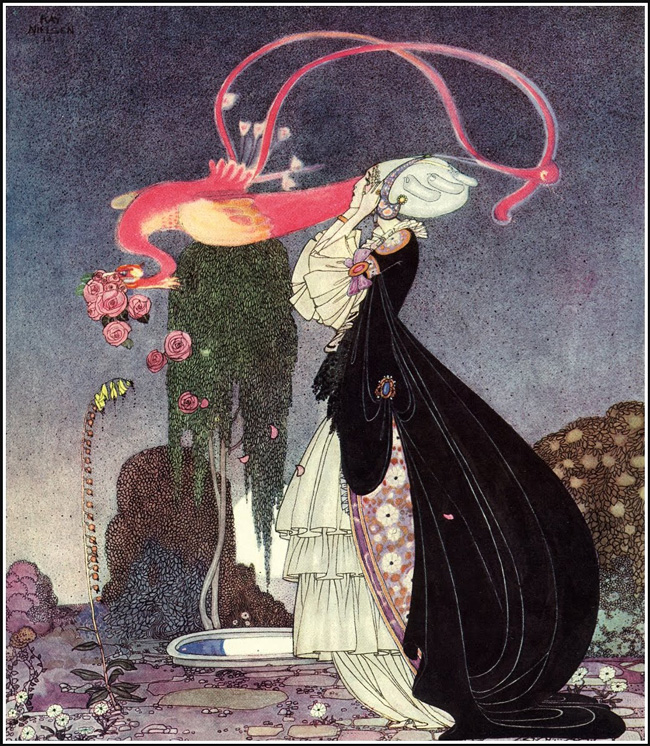 In Powder and Crinoline, 1912 (see the original post)
In Powder and Crinoline, 1912 (see the original post)
 In Powder and Crinoline, 1912 (see the original post)
In Powder and Crinoline, 1912 (see the original post)
 Hansel and Gretel / the Brothers Grimm, 1925 (see the original post)
Hansel and Gretel / the Brothers Grimm, 1925 (see the original post)
 Hansel and Gretel / the Brothers Grimm, 1925 (see the original post)
Hansel and Gretel / the Brothers Grimm, 1925 (see the original post)
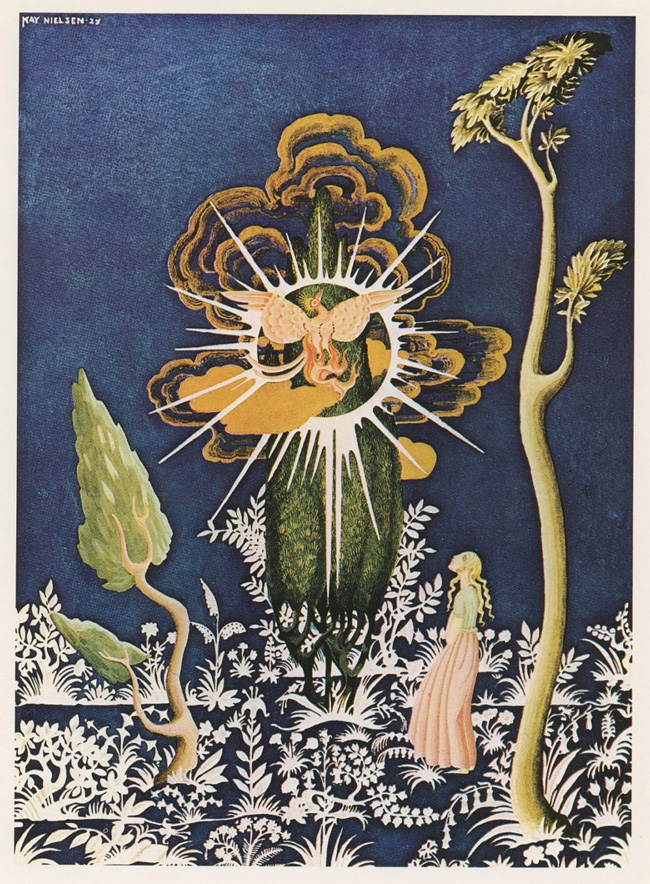 Hansel and Gretel / the Brothers Grimm, 1925 (see the original post)
Hansel and Gretel / the Brothers Grimm, 1925 (see the original post)

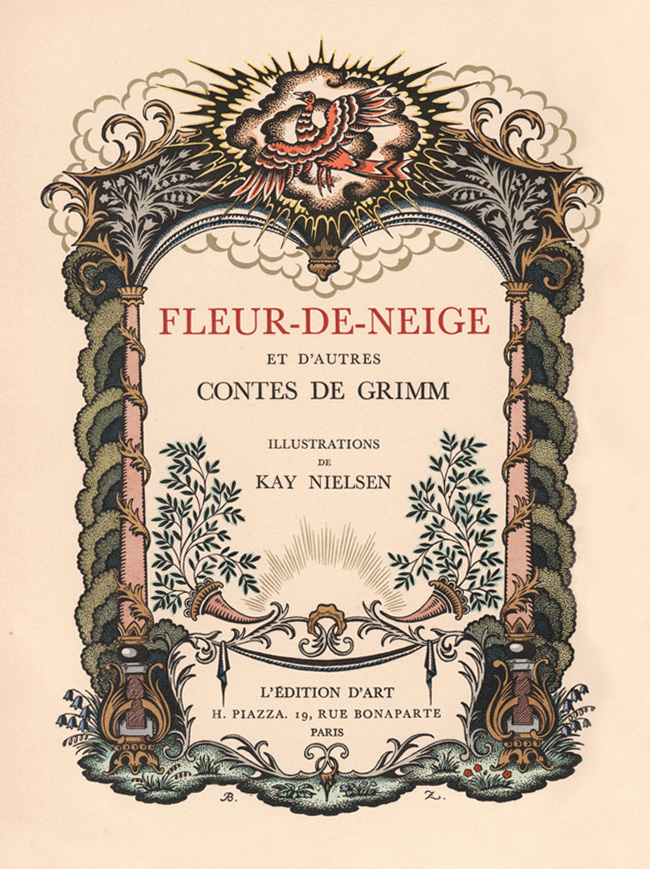

 Hansel and Gretel / the Brothers Grimm, 1925 (see the original post)
Hansel and Gretel / the Brothers Grimm, 1925 (see the original post)
 Hansel and Gretel / the Brothers Grimm, 1925 (see the original post)
Hansel and Gretel / the Brothers Grimm, 1925 (see the original post)
 Hansel and Gretel / the Brothers Grimm, 1925 (see the original post)
Hansel and Gretel / the Brothers Grimm, 1925 (see the original post)
 Hansel and Gretel / the Brothers Grimm, 1925 (see the original post)
Hansel and Gretel / the Brothers Grimm, 1925 (see the original post)
 Red Magic, 1930 (see the original post)
Red Magic, 1930 (see the original post)
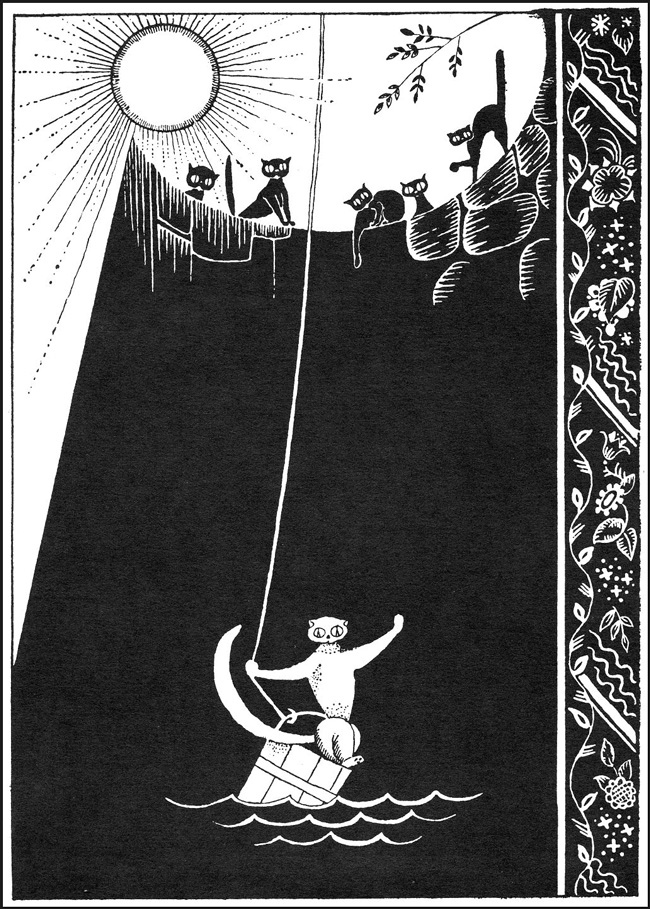 Red Magic, 1930 (see the original post)
Red Magic, 1930 (see the original post)
 Kay Nielsen, "Night on Bald Mountain" draft for Fantasia, 1940 via Frank Zumbach
Kay Nielsen, "Night on Bald Mountain" draft for Fantasia, 1940 via Frank Zumbach
 Drawing found on the inside cover of a German textbook for kids, Singen Spielen Basteln
Signed "Ada Bayer, 3/1/75"
Drawing found on the inside cover of a German textbook for kids, Singen Spielen Basteln
Signed "Ada Bayer, 3/1/75"
 Ursula Kirchner
Ursula Kirchner
 Ursula Kirchner
Ursula Kirchner
 Doris Lerche
Doris Lerche
 Axel Hertenstein
Axel Hertenstein
 Axel Hertenstein
Axel Hertenstein
 Janosch
I will investigate this guy (and a lot of the others, of course). Wikipedia entry says he is "one of the best-known German artists and children's book authors."
Janosch
I will investigate this guy (and a lot of the others, of course). Wikipedia entry says he is "one of the best-known German artists and children's book authors."
 Janosch
Janosch
 Benno Geisler
Benno Geisler
 Benno Geisler
Benno Geisler
 Malgorzata Konwerska, "Zwei Aschenbrödel" (Two Cinderellas?)
Malgorzata Konwerska, "Zwei Aschenbrödel" (Two Cinderellas?)
 Malgorzata Konwerska
Malgorzata Konwerska
 Jerzy Joachimiak
Jerzy Joachimiak
 Jerzy Joachimiak
Jerzy Joachimiak
 Peter Kaczmarek
Peter Kaczmarek
 Peter Kaczmarek
Peter Kaczmarek
 Peter Kaczmarek
Peter Kaczmarek
 Peter Kaczmarek
Peter Kaczmarek
 Manfred Feith-Umbehr, "Dornröschen oder Hundert Jahre Einsamkeit" (Sleeping Beauty and the Hundred Years of Solitude)
Manfred Feith-Umbehr, "Dornröschen oder Hundert Jahre Einsamkeit" (Sleeping Beauty and the Hundred Years of Solitude)


 Theodor Hosemann
Theodor Hosemann
 Gunther Stiller
Gunther Stiller
 ???
???
 Paulus Böhmer, "Fundevogel"
Paulus Böhmer, "Fundevogel"
 1930
This post began as a compilation of magazine covers from the website of a Japanese antiquarian dealer. I dug through all 1500 or so images and saved (like a good little digital hoarder) hundreds to feature, though only 8 made the first cut. This is because I decided to revisit Bookcover Design in Japan 1910s-40s (ISBN 4-89444-426-7; Amazon link). Edited by Masayo Matsubara and published in 2005 by PIE Books, this out-of-print treasure (Japanese-language only, unfortunately) features 650 book and magazine covers.
See my earlier posts for more.
1930
This post began as a compilation of magazine covers from the website of a Japanese antiquarian dealer. I dug through all 1500 or so images and saved (like a good little digital hoarder) hundreds to feature, though only 8 made the first cut. This is because I decided to revisit Bookcover Design in Japan 1910s-40s (ISBN 4-89444-426-7; Amazon link). Edited by Masayo Matsubara and published in 2005 by PIE Books, this out-of-print treasure (Japanese-language only, unfortunately) features 650 book and magazine covers.
See my earlier posts for more.
 1928
1928
 1928
1928
 1928
1928
 1929
1929
 1930
1930
 1927
1927
 1925
1925
 1928
1928
 1946 [thanks Ingrid!]
1946 [thanks Ingrid!]
 1946 [thanks Ingrid!]
1946 [thanks Ingrid!]
 1926
1926
 1934
1934
 1931
1931
 1926
1926
 1934
1934
 c. 1930s [update: found a better scan of this one]
c. 1930s [update: found a better scan of this one]
 c. 1930s
c. 1930s

 1945 [thanks Ingrid!]
1945 [thanks Ingrid!]
 1929
1929
 1932
1932
 1922
1922
 1917
1917
 1924
1924
 1954, cover by Manolo Prieto
see the original post
I had been saving Prieto for a stand-alone post (which I still might do some day). Monster Brains featured him recently and Galderich has arranged an exhibit. His covers are instantly recognizable.
1954, cover by Manolo Prieto
see the original post
I had been saving Prieto for a stand-alone post (which I still might do some day). Monster Brains featured him recently and Galderich has arranged an exhibit. His covers are instantly recognizable.
 1951, cover by Manolo Prieto
see the original post
1951, cover by Manolo Prieto
see the original post
 1931, Rivero Gil
see the original post
1931, Rivero Gil
see the original post
 1930, cover by Ramón Puyol
see the original post
1930, cover by Ramón Puyol
see the original post
 1930, cover by Rivera Gil
see the original post
1930, cover by Rivera Gil
see the original post
 1926, cover by Romà Bonet aka BON
see the original post
1926, cover by Romà Bonet aka BON
see the original post
 1923, cover by Romà Bonet aka BON
see the original post
1923, cover by Romà Bonet aka BON
see the original post
 1923, cover by Jaume Busquest
see the original post
1923, cover by Jaume Busquest
see the original post
 1933, cover illus. by Mauricio Amster
see the original post
1933, cover illus. by Mauricio Amster
see the original post
 1931, cover by Mauricio Amster
see the original post
1931, cover by Mauricio Amster
see the original post
 date unknown, illus. by Lluïsot
see the original post
[update: Es Pop alerted me that this was probably done in 2001; website for the very much alive and well Lluïsot.]
date unknown, illus. by Lluïsot
see the original post
[update: Es Pop alerted me that this was probably done in 2001; website for the very much alive and well Lluïsot.]
 1934, illus. by Quelus
see the original post
1934, illus. by Quelus
see the original post
 1934, illus. by Quelus
see the original post
1934, illus. by Quelus
see the original post
 1936
see the original post
1936
see the original post
 1923, children's book by Bartolozzi
see the original post
I love Bartolozzi.
1923, children's book by Bartolozzi
see the original post
I love Bartolozzi.
 1926, cover by Alfred Latour
see the original post
1926, cover by Alfred Latour
see the original post
 1911, cover illus. Joan Vila D'Ivori
see the original post
1911, cover illus. Joan Vila D'Ivori
see the original post
 1930, cover by Gori Munoz
see the original post
1930, cover by Gori Munoz
see the original post
 1931, illus. by Ignasi Vidal Molné
see the original post
1931, illus. by Ignasi Vidal Molné
see the original post
 1932, cover illus. by Viejo
see the original post
1932, cover illus. by Viejo
see the original post
 1929, anonymous illustrator
see the original post
1929, anonymous illustrator
see the original post
 1935, cover illus. by Monleón
see the original post
1935, cover illus. by Monleón
see the original post
 For the story behind this one click through to the original post
For the story behind this one click through to the original post
 1937, cover by Antoni Clavé
see the original post
See all posts tagged "Spain"
1937, cover by Antoni Clavé
see the original post
See all posts tagged "Spain"
 "Tetrahedra of Space," Wonder Stories cover, November 1931
I present here scans from expired Heritage Auction listings, following up on a October 2011 post of mid-20th-century science fiction and fantasy illustrations (Fantastic Plangent). I'll let two guys slightly more experienced in the field do the talking:"Paul remains the undisputed king of the pulp artists"—Arthur C. Clarke
"Paul's fantastic covers for Amazing Stories changed my life forever."—Ray Bradbury
From Wikipedia:Frank Rudolph Paul (April 18, 1884 - June 29, 1963) was an illustrator of US pulp magazines in the science fiction field. He was born in Vienna, Austria and died at his home in Teaneck, New Jersey.
A discovery of Hugo Gernsback (himself an immigrant from Luxembourg), Frank R. Paul was influential in defining what both cover art and interior illustrations in the nascent science fiction pulps of the 1920s looked like.
Two books of Paul's work (with the same material?): From the Pen of Paul: The Fantastic Images of Frank R. Paul and Frank R. Paul: Father of Science Fiction Art.
All artwork (c) Frank R. Paul estate ("If you are interested in obtaining rights to reprint Frank R. Paul's for commercial purposes, please contact Bill Engle, FRP's grandson at billengle@newmex.com")
"Tetrahedra of Space," Wonder Stories cover, November 1931
I present here scans from expired Heritage Auction listings, following up on a October 2011 post of mid-20th-century science fiction and fantasy illustrations (Fantastic Plangent). I'll let two guys slightly more experienced in the field do the talking:"Paul remains the undisputed king of the pulp artists"—Arthur C. Clarke
"Paul's fantastic covers for Amazing Stories changed my life forever."—Ray Bradbury
From Wikipedia:Frank Rudolph Paul (April 18, 1884 - June 29, 1963) was an illustrator of US pulp magazines in the science fiction field. He was born in Vienna, Austria and died at his home in Teaneck, New Jersey.
A discovery of Hugo Gernsback (himself an immigrant from Luxembourg), Frank R. Paul was influential in defining what both cover art and interior illustrations in the nascent science fiction pulps of the 1920s looked like.
Two books of Paul's work (with the same material?): From the Pen of Paul: The Fantastic Images of Frank R. Paul and Frank R. Paul: Father of Science Fiction Art.
All artwork (c) Frank R. Paul estate ("If you are interested in obtaining rights to reprint Frank R. Paul's for commercial purposes, please contact Bill Engle, FRP's grandson at billengle@newmex.com")
 original art for illustration, not dated
original art for illustration, not dated
 Science Fiction illustration, not dated
Science Fiction illustration, not dated
 Wonder Stories cover, August 1930
Wonder Stories cover, August 1930
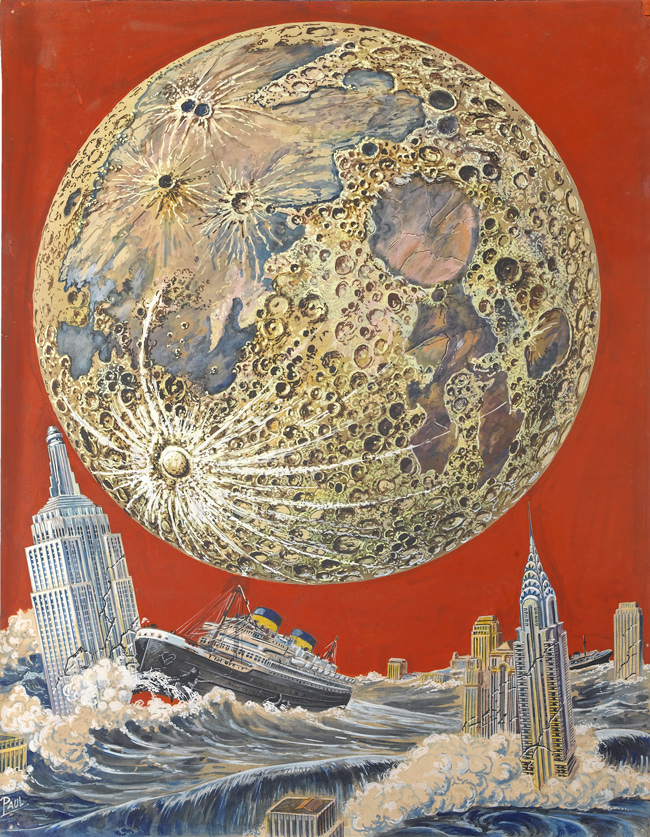 "Apocalyptic New York," Wonder Stories cover
"Apocalyptic New York," Wonder Stories cover
 Double-page Science Fiction story illustration
Double-page Science Fiction story illustration
 "Lord of Tranerica," Dynamic Science Stories cover, February 1939
"Lord of Tranerica," Dynamic Science Stories cover, February 1939
 "The Robot Aliens," Wonder Stories illustration, February 1935 cover
"The Robot Aliens," Wonder Stories illustration, February 1935 cover
 "The Robot Aliens," Wonder Stories illustration, February 1935
"The Robot Aliens," Wonder Stories illustration, February 1935
 Science fiction illustration
Science fiction illustration
 Amazing Stories, back cover, October 1945
Amazing Stories, back cover, October 1945
 "The 35th Millennium," Wonder Stories cover, August 1931
"The 35th Millennium," Wonder Stories cover, August 1931
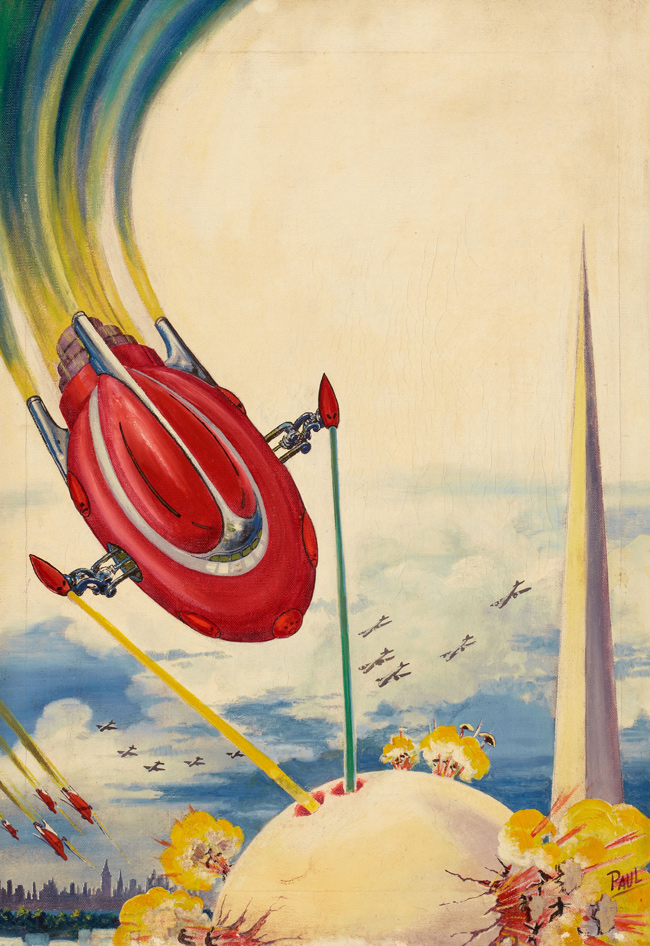 Science Fiction cover, June 1939
Science Fiction cover, June 1939
 "Off to Space," Science Fiction Plus interior illustration, March 1953
"Off to Space," Science Fiction Plus interior illustration, March 1953
 "The Biological Revolt," Science Fiction Plus illustration, March 1953
"The Biological Revolt," Science Fiction Plus illustration, March 1953
 "Stories of the Stars - Aldebaran," Fantastic Adventures back cover, December 1945
"Stories of the Stars - Aldebaran," Fantastic Adventures back cover, December 1945
 "West Point of Tomorrow," Thrilling Wonder Stories, September 1940
(I hope there's a contrarian out there still using the term "Scientifiction.")
"West Point of Tomorrow," Thrilling Wonder Stories, September 1940
(I hope there's a contrarian out there still using the term "Scientifiction.")
 "The Planet Juggler," story illustration
"The Planet Juggler," story illustration
 "As Mars Sees Us," 1940
"As Mars Sees Us," 1940
 Science Fiction Plus digest cover, December 1953
Science Fiction Plus digest cover, December 1953
 "Rockets and Men," interior story illustration
"Rockets and Men," interior story illustration
 "The End of the Moon," Science Fiction Plus back-cover, August 1953
"The End of the Moon," Science Fiction Plus back-cover, August 1953
 Bio from the Kodomo No Kuni site:Takei was born in Suwa, Nagano prefecture in 1894. After studying at the Hongo Yoga Kenkyujo (Hongo Research Institute for Western Art) he entered the Western-style art department of Tokyo Art School in 1919. He was an ardent admirer of illustrator Takehisa Yumeji and poet Kitahara Hakushu. After graduation from art school, he married in 1921 and to support his new family he began to produce illustrations for children for Kodomo no tomo [Child's Friend], a children's magazine published by Fujin no Tomo Sha. In 1922 he became one of the leading illustrators for Kodomo no kuni [Children's Land] from its inaugural issue. In 1923 he published Otogi no tamago [The Fairy's Egg], and in 1925 his first individual exhibition was held in Ginza in the heart of Tokyo. His Ramu-ramu O [King Ramu-ramu] came out in 1926. The following year, with Shimizu Yoshio, Okamoto Kiichi, Kawakami Shiro, and other illustrators contributing to the Kodomo no kuni, Takei formed the Nihon Doga Kyokai (Japan Association of Illustration for Children), as part of the effort to achieve artistic quality in illustrations for children. Following Okamoto's death, Takei succeeded him as critic and selector of illustrations submitted to Kodomo no kuni in 1931. In 1955, he became editorial adviser for the magazine Kinda bukku [Kinder Book].
I again found these images in the database of the National Diet Library.
Some of Takei's books have been reprinted and are available from amazon.co.jp.
Previous posts on this artist
Bio from the Kodomo No Kuni site:Takei was born in Suwa, Nagano prefecture in 1894. After studying at the Hongo Yoga Kenkyujo (Hongo Research Institute for Western Art) he entered the Western-style art department of Tokyo Art School in 1919. He was an ardent admirer of illustrator Takehisa Yumeji and poet Kitahara Hakushu. After graduation from art school, he married in 1921 and to support his new family he began to produce illustrations for children for Kodomo no tomo [Child's Friend], a children's magazine published by Fujin no Tomo Sha. In 1922 he became one of the leading illustrators for Kodomo no kuni [Children's Land] from its inaugural issue. In 1923 he published Otogi no tamago [The Fairy's Egg], and in 1925 his first individual exhibition was held in Ginza in the heart of Tokyo. His Ramu-ramu O [King Ramu-ramu] came out in 1926. The following year, with Shimizu Yoshio, Okamoto Kiichi, Kawakami Shiro, and other illustrators contributing to the Kodomo no kuni, Takei formed the Nihon Doga Kyokai (Japan Association of Illustration for Children), as part of the effort to achieve artistic quality in illustrations for children. Following Okamoto's death, Takei succeeded him as critic and selector of illustrations submitted to Kodomo no kuni in 1931. In 1955, he became editorial adviser for the magazine Kinda bukku [Kinder Book].
I again found these images in the database of the National Diet Library.
Some of Takei's books have been reprinted and are available from amazon.co.jp.
Previous posts on this artist
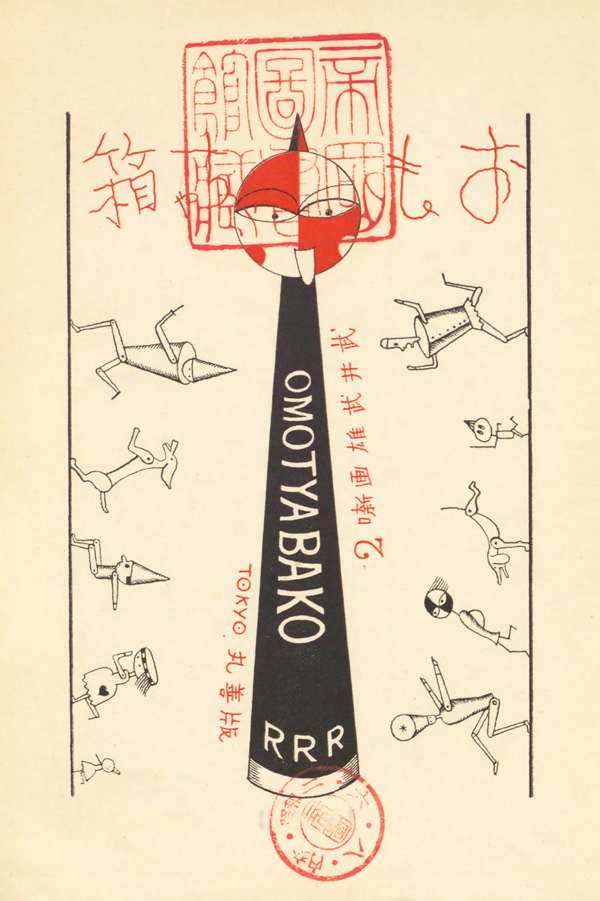
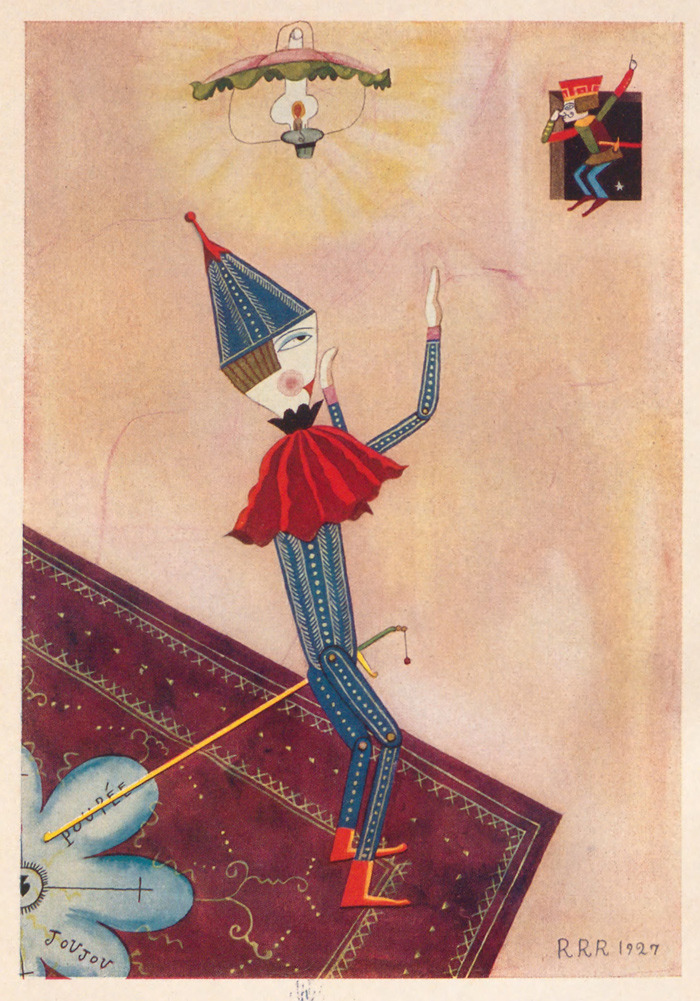
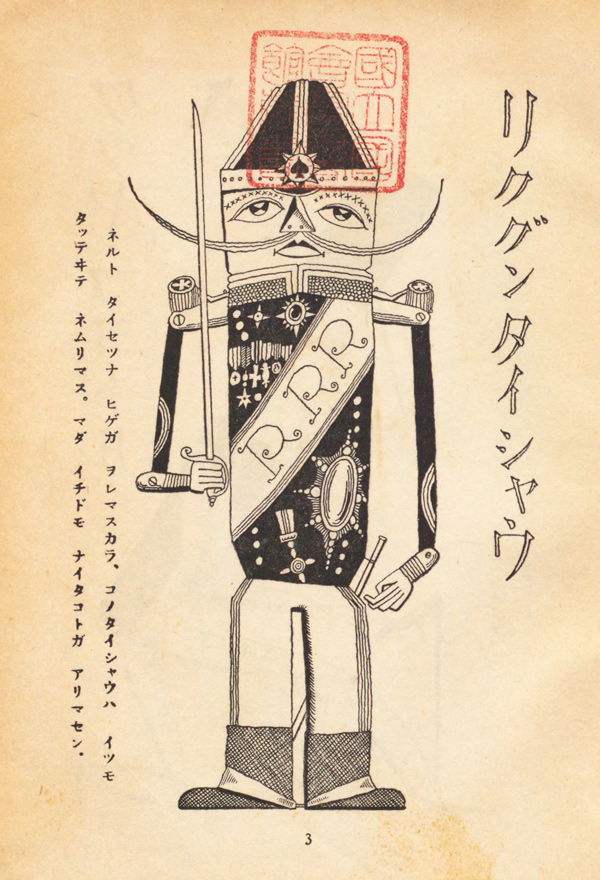
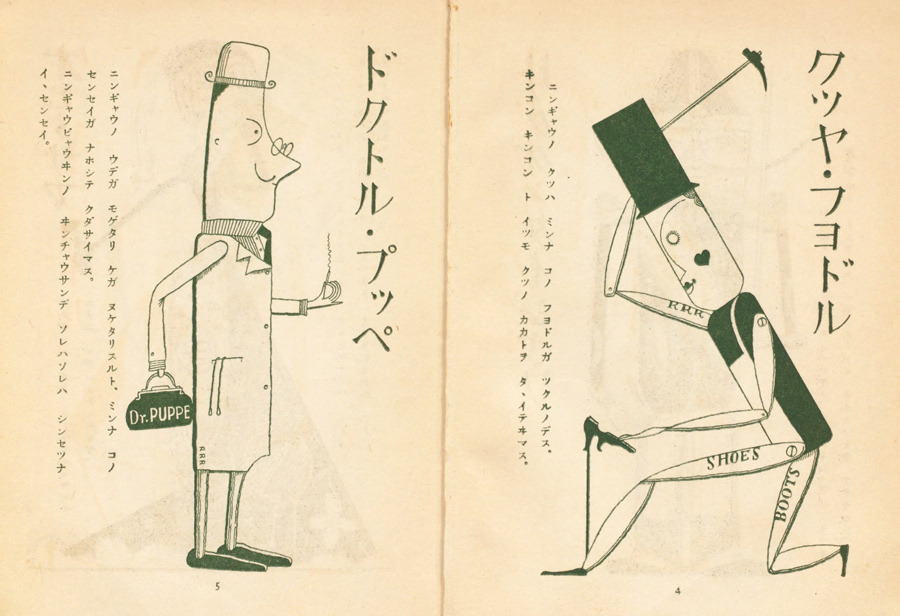
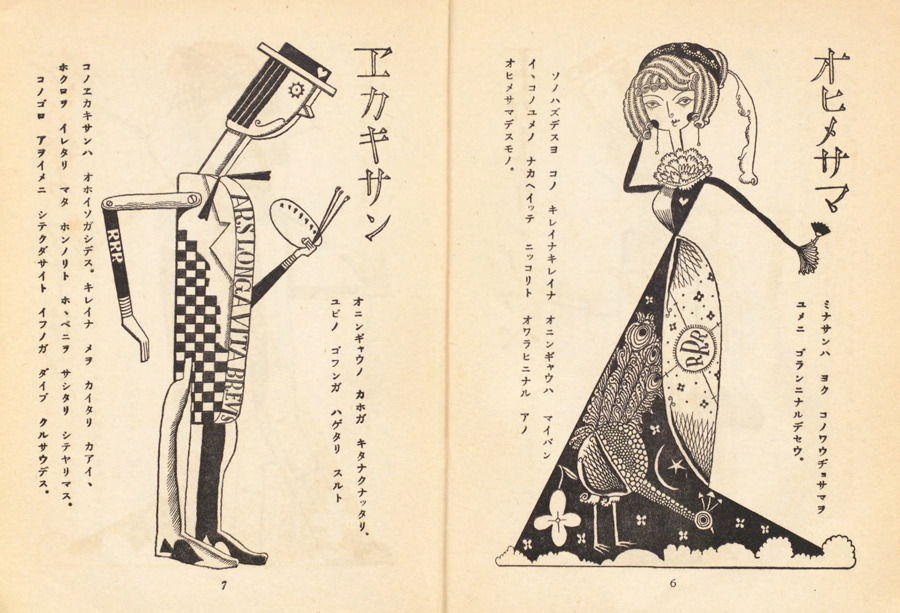
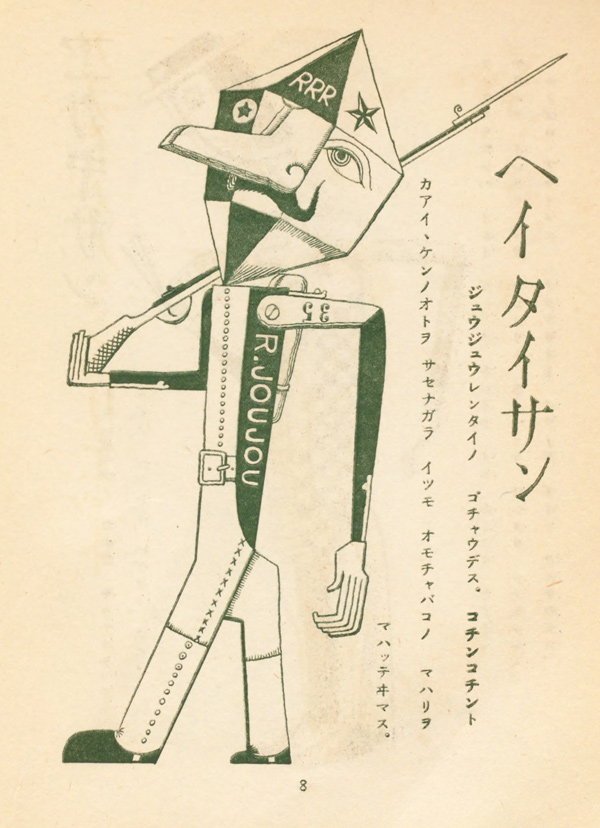
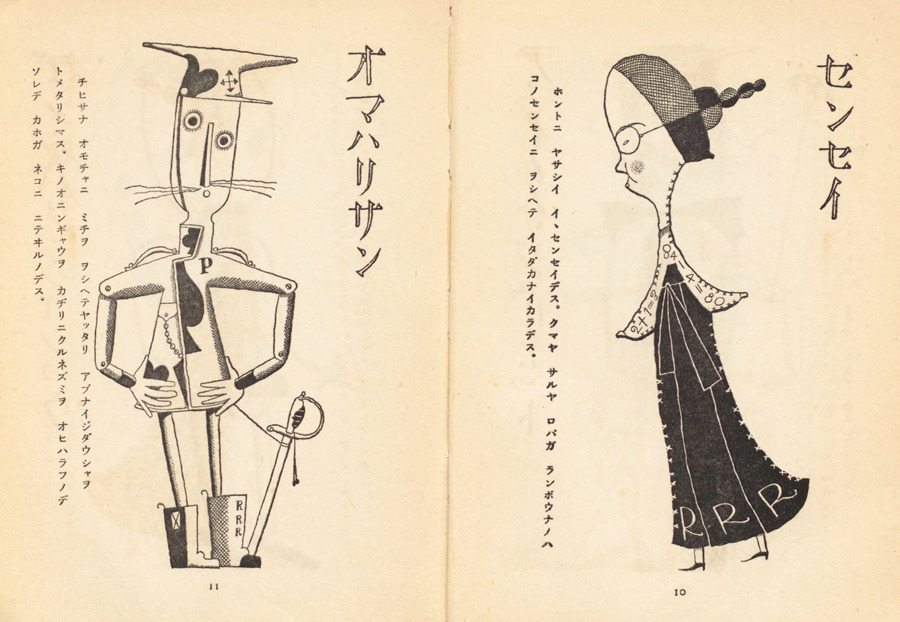
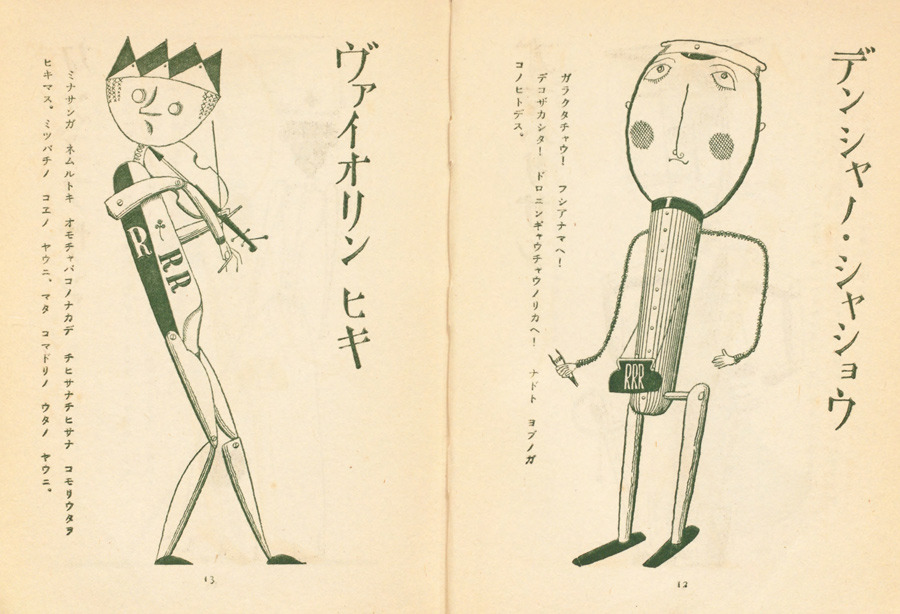
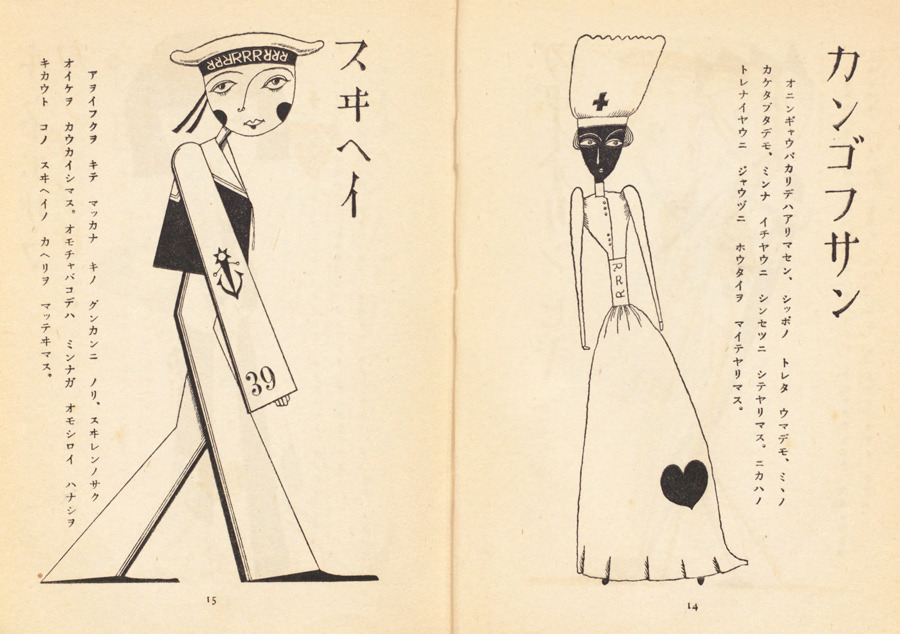
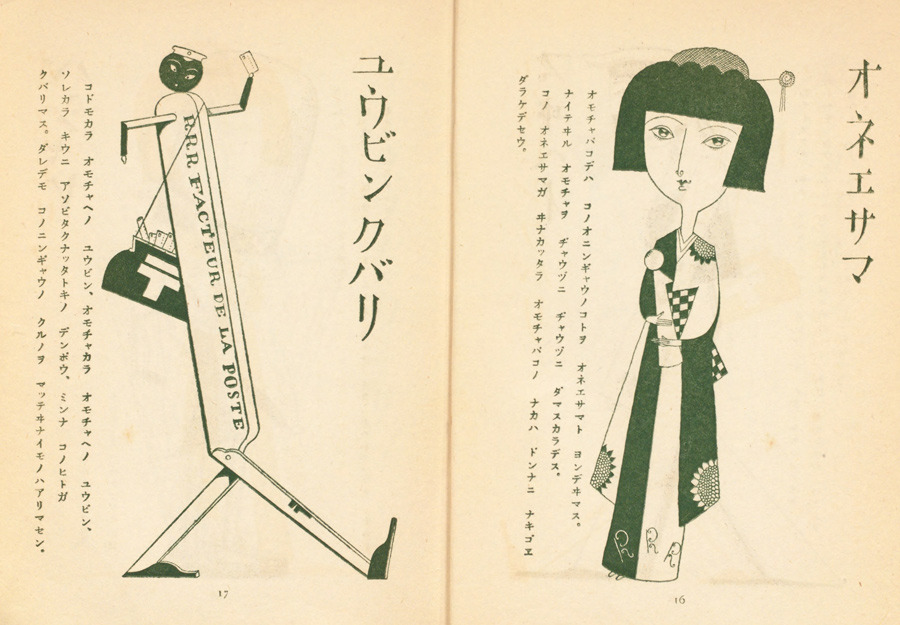
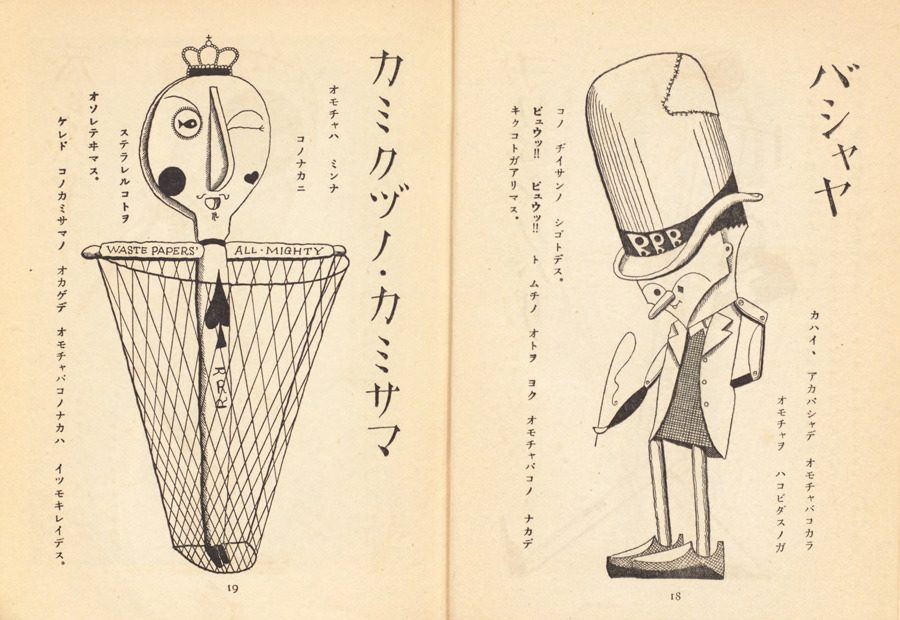
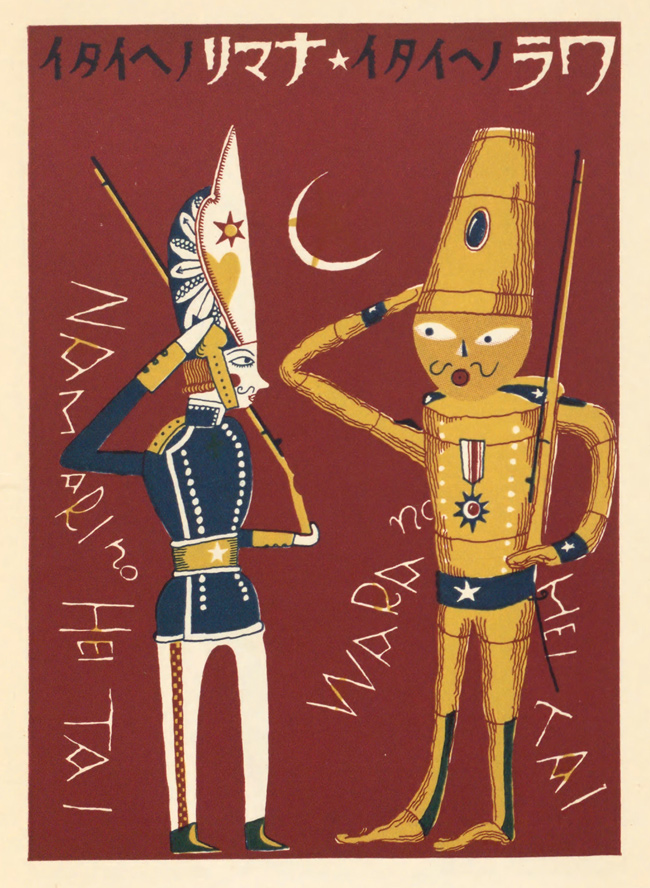
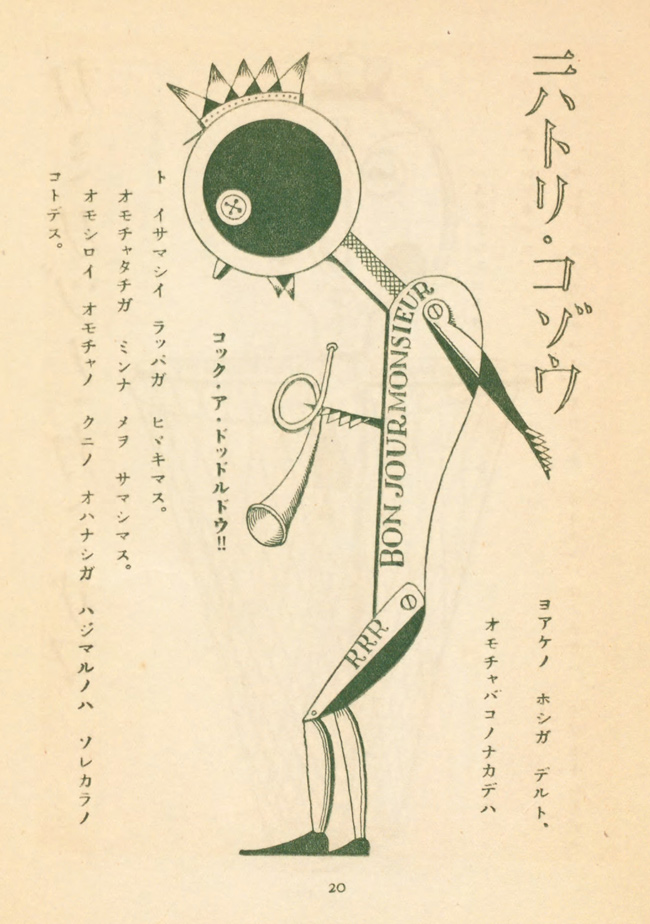
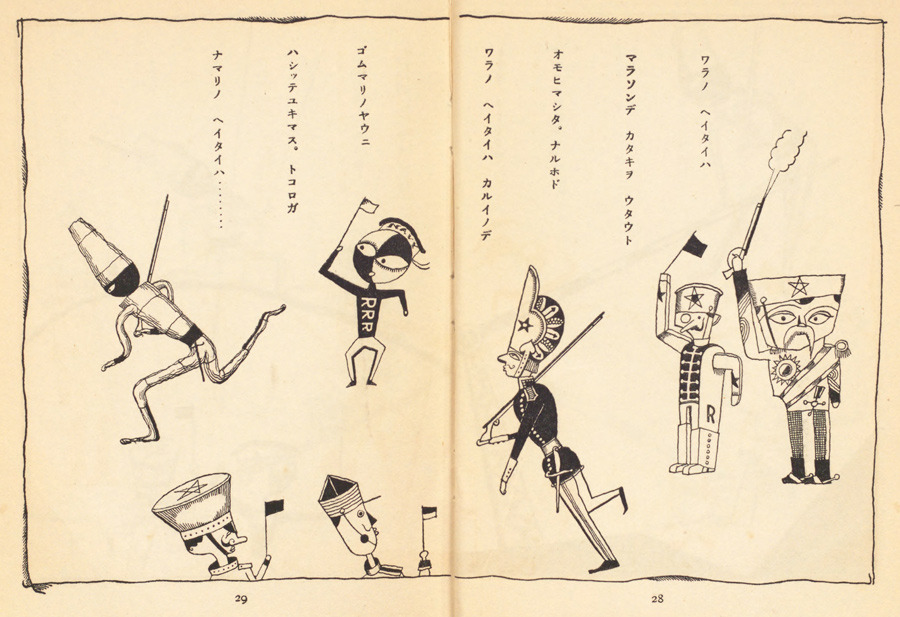

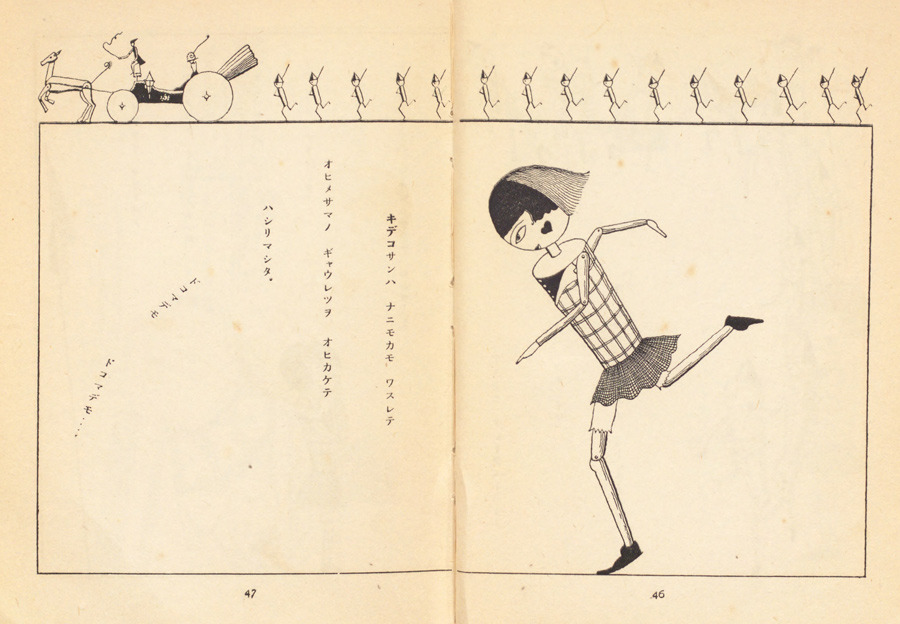
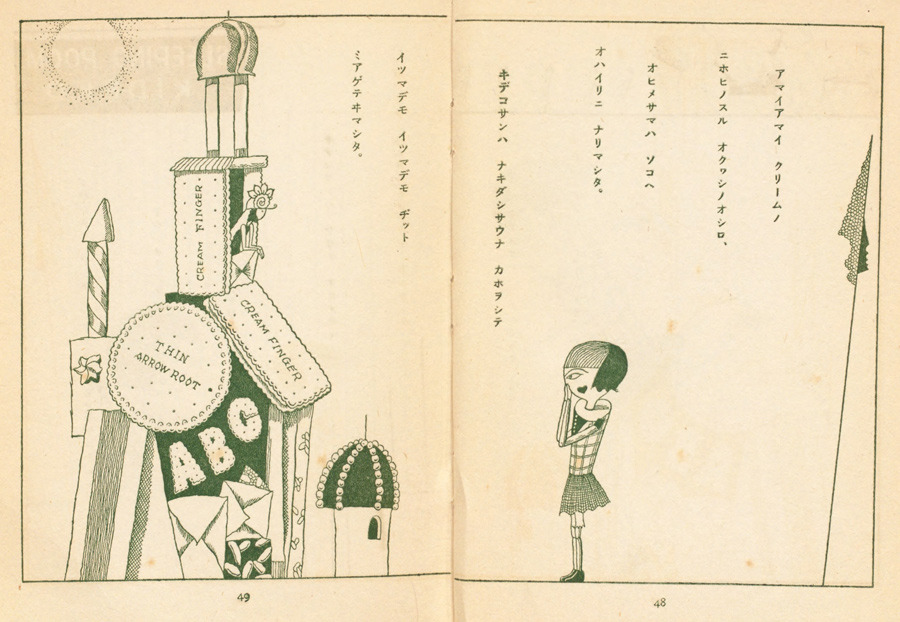
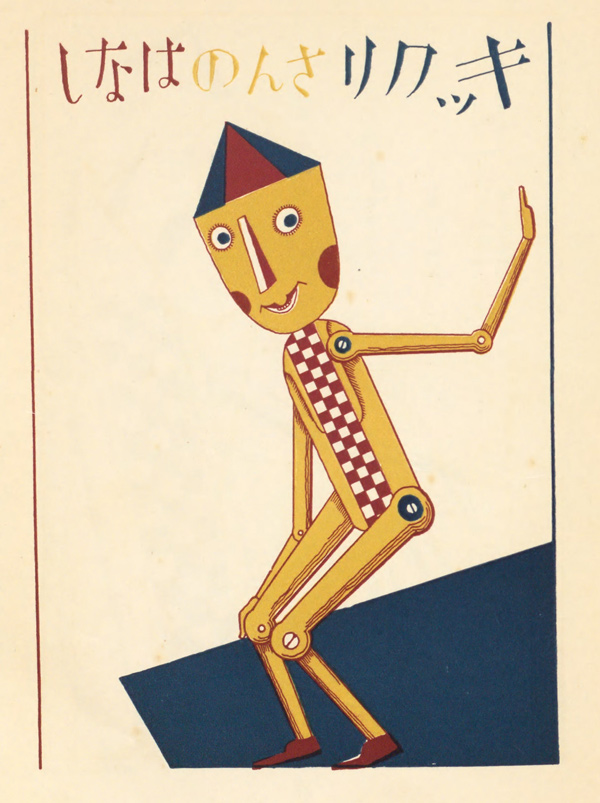
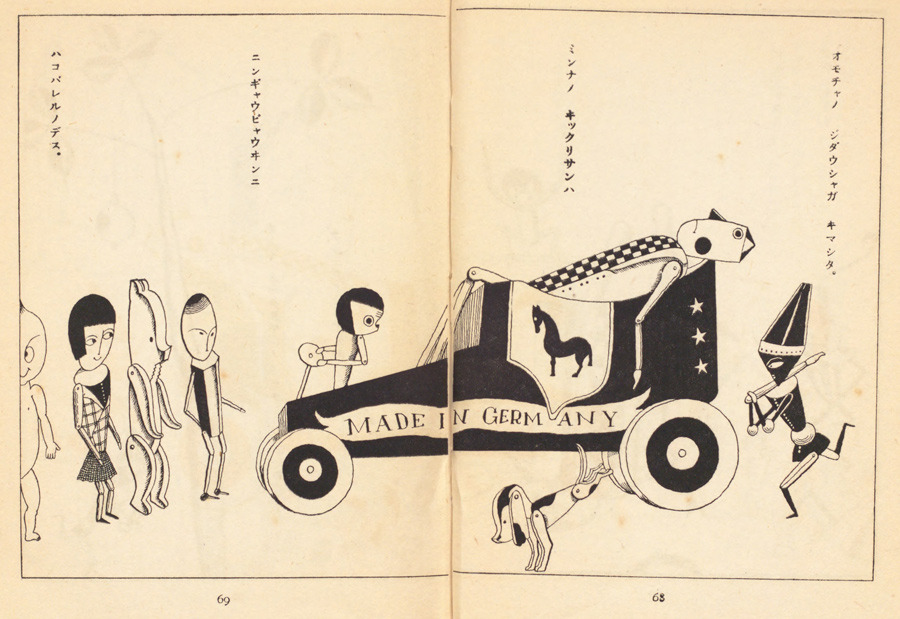
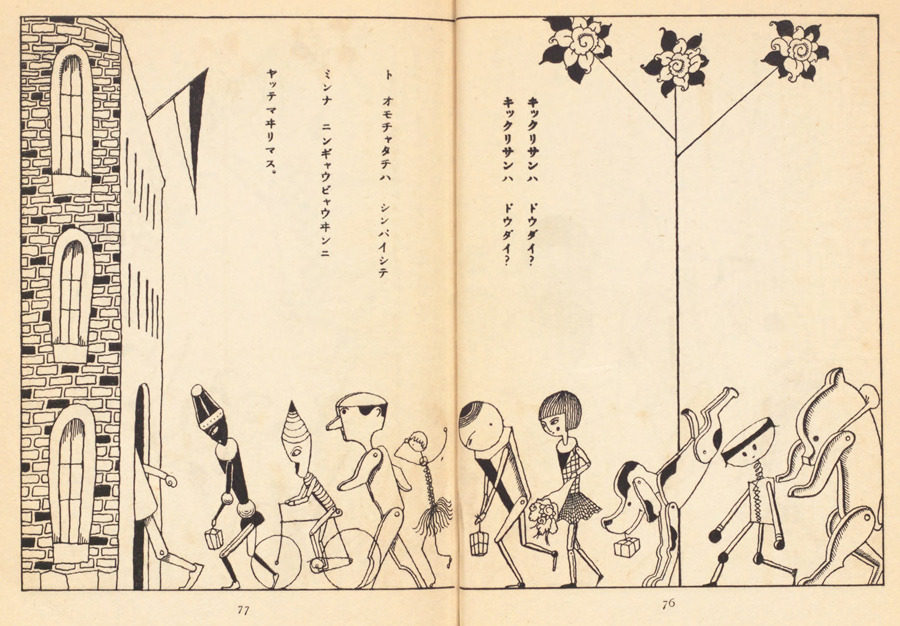

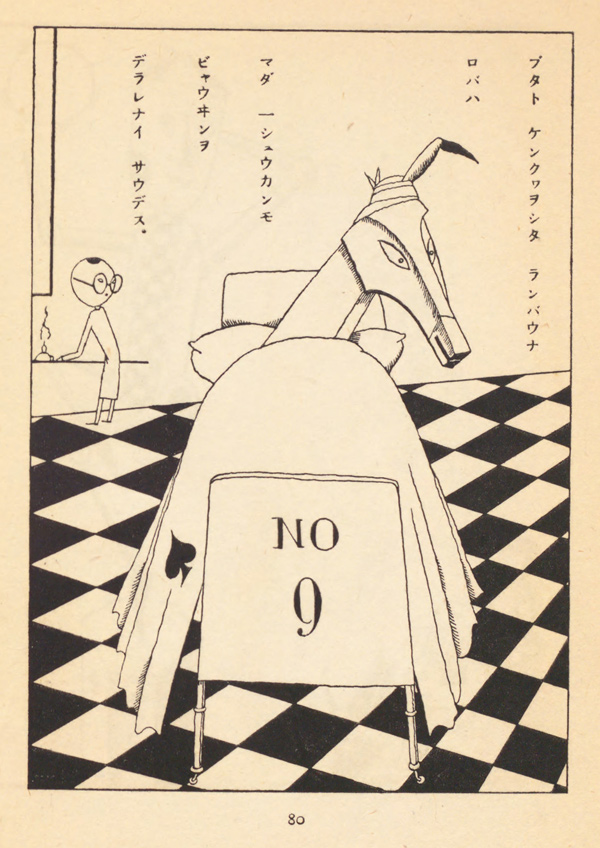
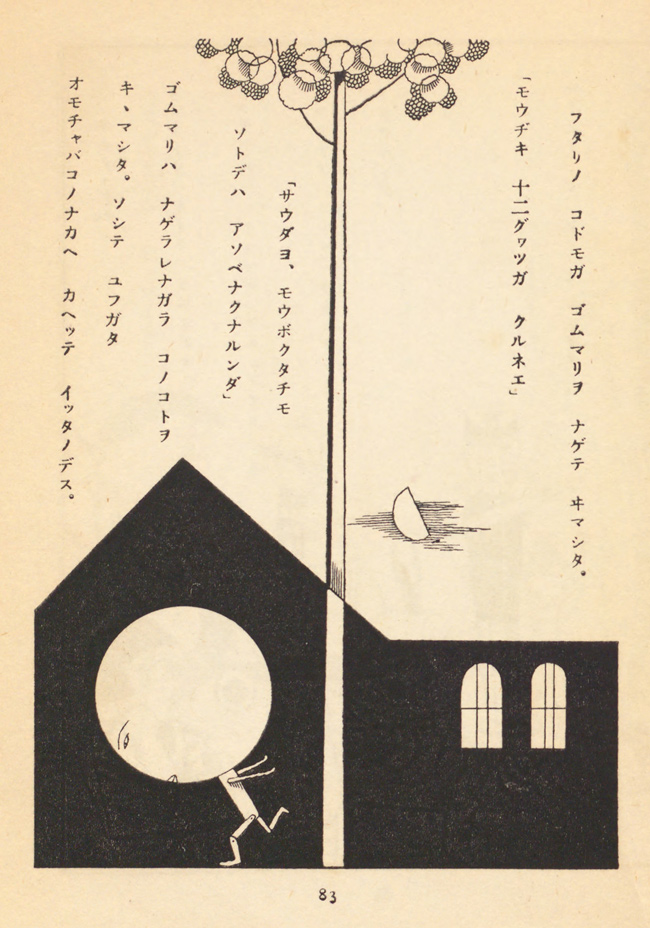
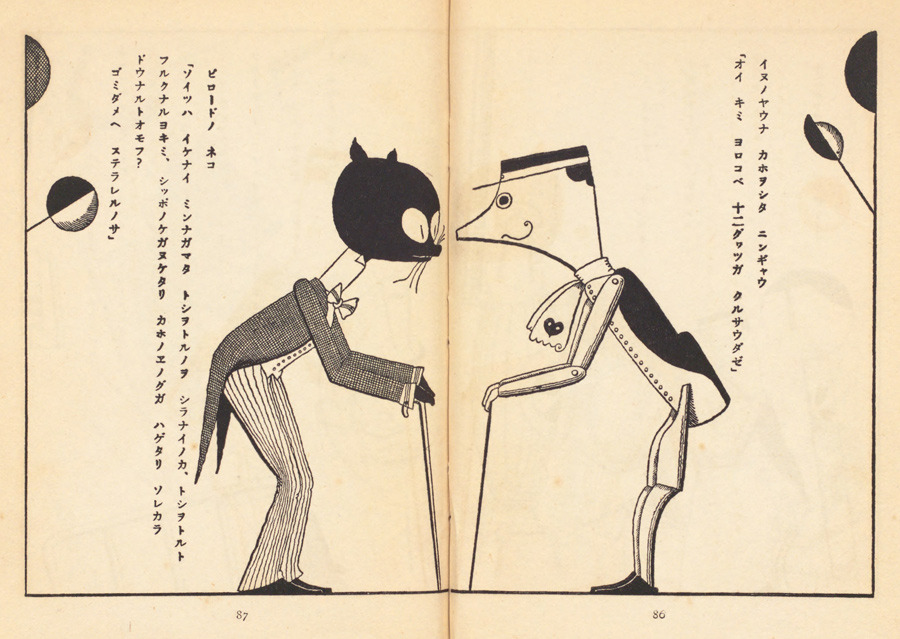
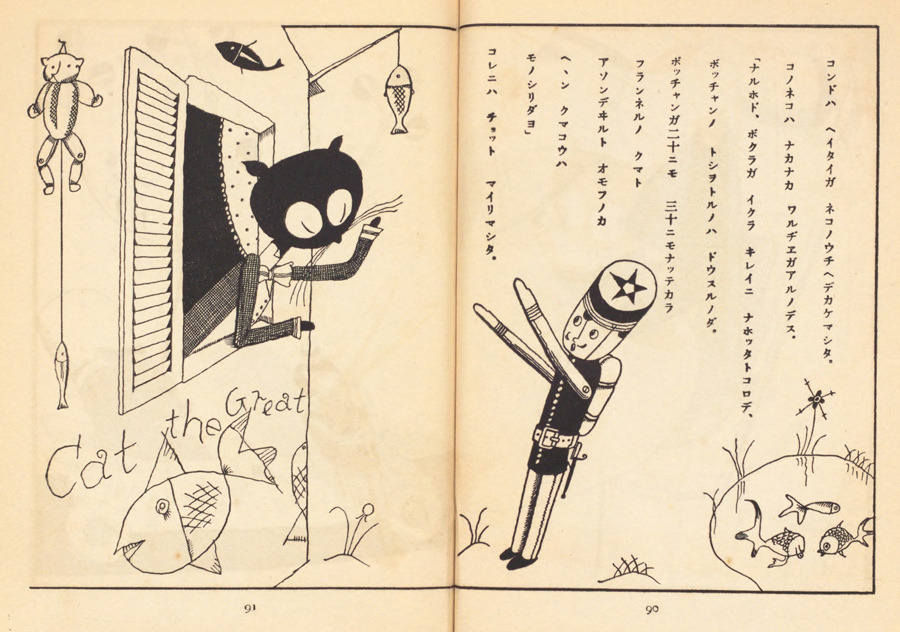
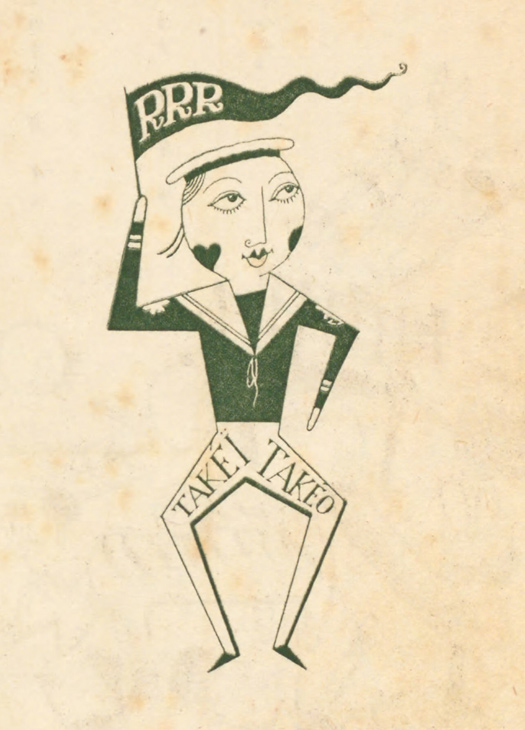 from the back cover
"RRR" is his usual signature
Previous posts on this artist
from the back cover
"RRR" is his usual signature
Previous posts on this artist
 Description of the portfolio from a Lawrence University library exhibit:
According to Theime-Becker, this portfolio was the most significant of the many "death dances" produced during the First World War. In its style, one recognizes immediately Wirsching's international allusion to the medieval German masters of the woodcut. His choice of images, however, is distinctly modern: the figure of Death, in the traditional form of a skeleton, confronts a variety of contemporary figures who will meet their doom as a result of the devastation of this new war. The first plate shows a peasant in the field learning of the declaration of war from his newspaper; Death appears over his shoulder and steals the farmer's scythe. In another plate, Wirsching shows Death leading a spy by a rope, depicted as the obvious Jewish stereotype of the moneylender-evidence of the prevalence in German society of this anti-Semitic view... As a whole, Vom Totentanz is a grim indictment of the evil of war and man's innate inhumanity to man. By alluding so directly to the hallowed stylistic tradition of the German Totentanz, Wirsching's philosophical message is all the more damning.
Description of the portfolio from a Lawrence University library exhibit:
According to Theime-Becker, this portfolio was the most significant of the many "death dances" produced during the First World War. In its style, one recognizes immediately Wirsching's international allusion to the medieval German masters of the woodcut. His choice of images, however, is distinctly modern: the figure of Death, in the traditional form of a skeleton, confronts a variety of contemporary figures who will meet their doom as a result of the devastation of this new war. The first plate shows a peasant in the field learning of the declaration of war from his newspaper; Death appears over his shoulder and steals the farmer's scythe. In another plate, Wirsching shows Death leading a spy by a rope, depicted as the obvious Jewish stereotype of the moneylender-evidence of the prevalence in German society of this anti-Semitic view... As a whole, Vom Totentanz is a grim indictment of the evil of war and man's innate inhumanity to man. By alluding so directly to the hallowed stylistic tradition of the German Totentanz, Wirsching's philosophical message is all the more damning.
 Wirsching bio (1889–1919) from the same site: Despite his thorough knowledge of Mediterranean art, Wirsching’s greatest artistic inspirations were the paintings and woodcuts of the great German masters of the Renaissance; he studied these works avidly at Munich’s City Library. When he returned to Munich at the beginning of 1913, he moved to the nearby village of Dachau, since the 1880s an important artists’ colony of the naturalist school. When war broke out, he served in the artillery, but was back in Dachau by 1916. Here he painted and also perfected his skill as a graphic artist, creating a fanciful style that translated his knowledge of the German Masters into a modern idiom. He became a leading artist of the new Dachau school, which took on a more Expressionist mode. He supported himself by making woodcut ex-libris and greeting cards for members of Munich’s artistic circles. He married in Dachau the Hungarian painter, Ankara Kowatsch. Signs of the mental instability—no doubt exacerbated by the unrecognizable presence of a brain tumor—began to appear in 1916 or 1917. He continued nonetheless to produce woodcut series and illustrations for books, as well as paintings which incorporated traditionally religious and mythological motifs into contemporary settings. While placing a new print into the press, he fell dead to the ground, the victim of a stroke. [via]
Wirsching bio (1889–1919) from the same site: Despite his thorough knowledge of Mediterranean art, Wirsching’s greatest artistic inspirations were the paintings and woodcuts of the great German masters of the Renaissance; he studied these works avidly at Munich’s City Library. When he returned to Munich at the beginning of 1913, he moved to the nearby village of Dachau, since the 1880s an important artists’ colony of the naturalist school. When war broke out, he served in the artillery, but was back in Dachau by 1916. Here he painted and also perfected his skill as a graphic artist, creating a fanciful style that translated his knowledge of the German Masters into a modern idiom. He became a leading artist of the new Dachau school, which took on a more Expressionist mode. He supported himself by making woodcut ex-libris and greeting cards for members of Munich’s artistic circles. He married in Dachau the Hungarian painter, Ankara Kowatsch. Signs of the mental instability—no doubt exacerbated by the unrecognizable presence of a brain tumor—began to appear in 1916 or 1917. He continued nonetheless to produce woodcut series and illustrations for books, as well as paintings which incorporated traditionally religious and mythological motifs into contemporary settings. While placing a new print into the press, he fell dead to the ground, the victim of a stroke. [via]






 "Wirshing shows Death leading a spy by a rope, depicted as the obvious Jewish stereotype of the moneylender—evidence of the prevalence in German society of this anti-Semitic view."
"Wirshing shows Death leading a spy by a rope, depicted as the obvious Jewish stereotype of the moneylender—evidence of the prevalence in German society of this anti-Semitic view."
 See all posts from the collection of Richard Sica
See all posts from the collection of Richard Sica
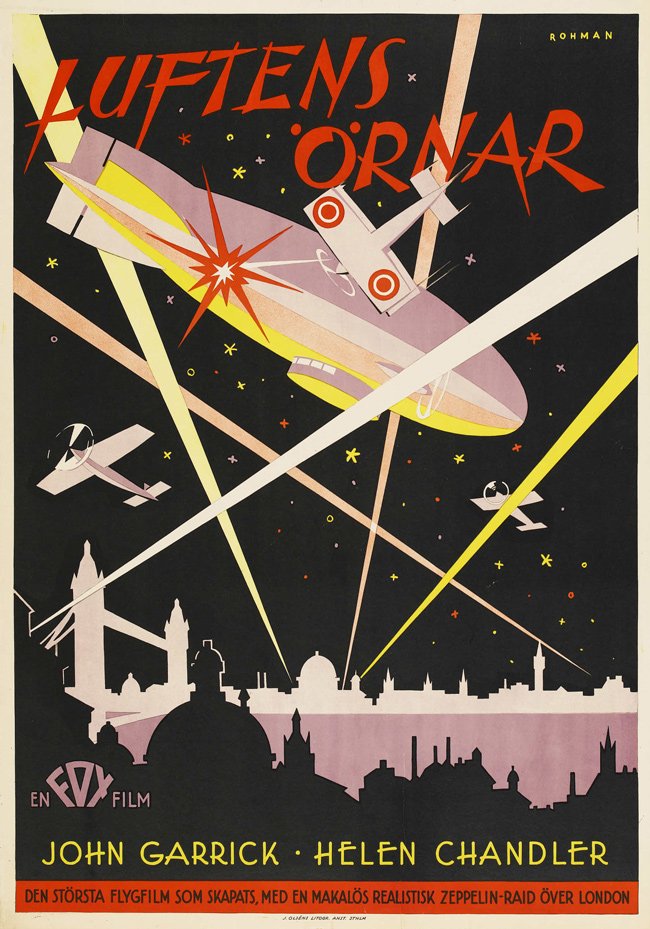 Sky Hawk, 1929 (artist: Eric Rohman)
I found these posters as expired auction listings (this time at mighty timesink Heritage). I'm also working on a fourth post of work by Einar Nerman, so perhaps another all-Sweden week...
Many Swedish movie posters from this era must have played off of the original American ones, though I have the sense that the works featured here are original deco confections.
See all posts tagged Sweden.
Sky Hawk, 1929 (artist: Eric Rohman)
I found these posters as expired auction listings (this time at mighty timesink Heritage). I'm also working on a fourth post of work by Einar Nerman, so perhaps another all-Sweden week...
Many Swedish movie posters from this era must have played off of the original American ones, though I have the sense that the works featured here are original deco confections.
See all posts tagged Sweden.
 Death Takes a Holiday, 1934 (artist: Moje Aslund)
Death Takes a Holiday, 1934 (artist: Moje Aslund)
 The Walking Dead, 1936 (artist: Castegren)
The Walking Dead, 1936 (artist: Castegren)
 Things to Come, 1936 (artist: Moje Aslund)
Things to Come, 1936 (artist: Moje Aslund)
 Champes of the Champs-Elysses (artist: Eric Rohman)
Champes of the Champs-Elysses (artist: Eric Rohman)
 detail
detail
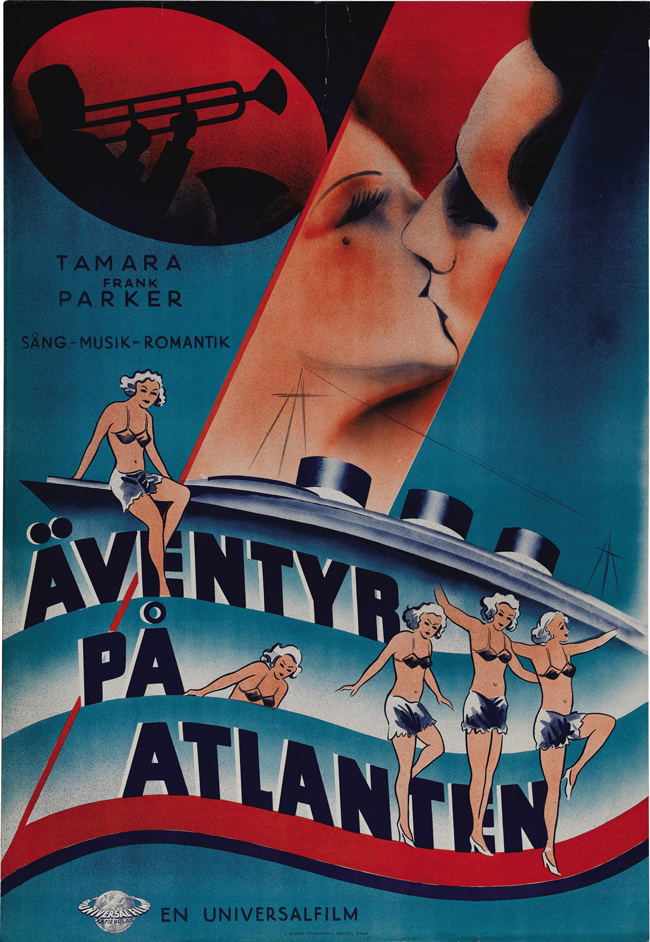 Sweet Surrender, 1935
Sweet Surrender, 1935
 Hit the Deck, 1930
update: Brian Moore tells me this art is by Russell Patterson
Hit the Deck, 1930
update: Brian Moore tells me this art is by Russell Patterson
 One Night of Love, 1934
One Night of Love, 1934
 Invisible Stripes, 1939
Invisible Stripes, 1939
 Angels with Dirty Faces, 1938 (artist: Eric Rohman)
Angels with Dirty Faces, 1938 (artist: Eric Rohman)
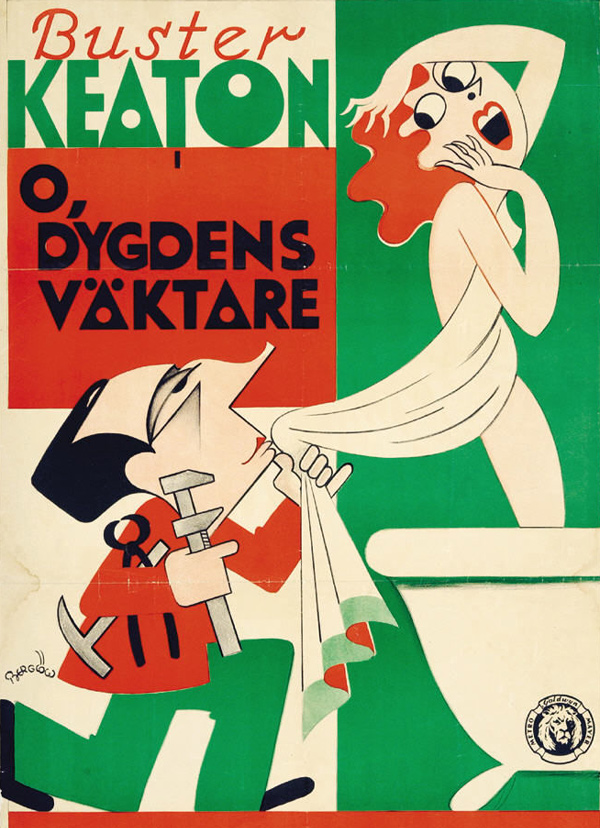 The Passionate Plumber, 1932 (artist: Carl Gustav Berglow)
The Passionate Plumber, 1932 (artist: Carl Gustav Berglow)
 Shanghaied, 1920s (artist: Eric Rohman)
Shanghaied, 1920s (artist: Eric Rohman)
 Dance Fools Dance, 1931 (artist: Eric Rohman)
Dance Fools Dance, 1931 (artist: Eric Rohman)
 Greed, 1924 (artist: Eric Rohman)
Greed, 1924 (artist: Eric Rohman)
 The Easiest Way, 1931 (artist: Eric Rohman)
The Easiest Way, 1931 (artist: Eric Rohman)
 Woman in the Moon, 1929
Woman in the Moon, 1929
 The Black Cat, 1934
The Black Cat, 1934
 Whoopee!, 1930 (artist: Eric Rohman)
Whoopee!, 1930 (artist: Eric Rohman)
 Frankenstein, 1931
Frankenstein, 1931
 Illus. by Artuš Scheiner for Under Command Of Magic by J. Š. Kubín (1920s)
see the original flickr post by Josef Skrhola
For the last few years, my flickr friend Josef Skrhola has been documenting the work of Artuš Scheiner, scanning 384 images from at least ten different books. I've pulled some of my favorites for this post.
A Cotsen Children's Library exhibit calls Scheiner "a prolific Bohemian artist, whose work was widely published in Czechoslovakia and Austria" and adds that "except for his illustrations for Božena Nemcová's The Disobedient Kids and other Czecho-Slovak Fairy Tales (1921), Scheiner's work is not well known in the English-speaking world."
Cobbling some facts from a Google Translation of the Czech wikipedia entry:
Scheiner, working as a financial clerk in Prague, began drawing as a hobby. He was completely self-taught. Soon magazines in Austria, Germany, and Hungary began publishing his drawings. From 1897 he began publishing in various Czech magazines, and 1902 saw the release of his first book of fairy tale illustrations.
Illus. by Artuš Scheiner for Under Command Of Magic by J. Š. Kubín (1920s)
see the original flickr post by Josef Skrhola
For the last few years, my flickr friend Josef Skrhola has been documenting the work of Artuš Scheiner, scanning 384 images from at least ten different books. I've pulled some of my favorites for this post.
A Cotsen Children's Library exhibit calls Scheiner "a prolific Bohemian artist, whose work was widely published in Czechoslovakia and Austria" and adds that "except for his illustrations for Božena Nemcová's The Disobedient Kids and other Czecho-Slovak Fairy Tales (1921), Scheiner's work is not well known in the English-speaking world."
Cobbling some facts from a Google Translation of the Czech wikipedia entry:
Scheiner, working as a financial clerk in Prague, began drawing as a hobby. He was completely self-taught. Soon magazines in Austria, Germany, and Hungary began publishing his drawings. From 1897 he began publishing in various Czech magazines, and 1902 saw the release of his first book of fairy tale illustrations.
 Illus. by Artuš Scheiner for Under Command Of Magic by J. Š. Kubín (1920s)
see the original flickr post by Josef Skrhola
Illus. by Artuš Scheiner for Under Command Of Magic by J. Š. Kubín (1920s)
see the original flickr post by Josef Skrhola
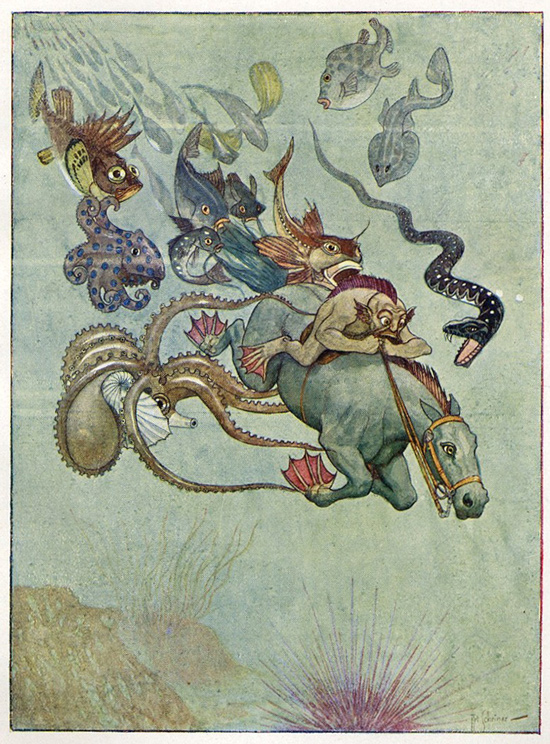 Illus. by Artuš Scheiner for Under Command Of Magic by J. Š. Kubín (1920s)
see the original flickr post by Josef Skrhola
Illus. by Artuš Scheiner for Under Command Of Magic by J. Š. Kubín (1920s)
see the original flickr post by Josef Skrhola
 Illus. by Artuš Scheiner for Under Command Of Magic by J. Š. Kubín (1920s)
see the original flickr post by Josef Skrhola
Illus. by Artuš Scheiner for Under Command Of Magic by J. Š. Kubín (1920s)
see the original flickr post by Josef Skrhola
 Illus. by Artuš Scheiner for Hoffmann's The Nutcracker and the Mouse King (1924)
see the original flickr post by Josef Skrhola
Illus. by Artuš Scheiner for Hoffmann's The Nutcracker and the Mouse King (1924)
see the original flickr post by Josef Skrhola
 Illus. by Artuš Scheiner for Hoffmann's The Nutcracker and the Mouse King (1924)
see the original flickr post by Josef Skrhola
Illus. by Artuš Scheiner for Hoffmann's The Nutcracker and the Mouse King (1924)
see the original flickr post by Josef Skrhola
 Illus. by Artuš Scheiner for Hoffmann's The Nutcracker and the Mouse King (1924)
see the original flickr post by Josef Skrhola
Illus. by Artuš Scheiner for Hoffmann's The Nutcracker and the Mouse King (1924)
see the original flickr post by Josef Skrhola
 Illus. by Artuš Scheiner for Romance About The Faithful Friendship Of Amis And Amil,
a novel by Julius Zeyer
see the original flickr post by Josef Skrhola
Illus. by Artuš Scheiner for Romance About The Faithful Friendship Of Amis And Amil,
a novel by Julius Zeyer
see the original flickr post by Josef Skrhola
 Illus. by Artuš Scheiner for František Ruth's Ancient Fairy-Tales (1920)
see the original flickr post by Josef Skrhola
Illus. by Artuš Scheiner for František Ruth's Ancient Fairy-Tales (1920)
see the original flickr post by Josef Skrhola
 Illus. by Artuš Scheiner for František Ruth's Ancient Fairy-Tales (1920)
see the original flickr post by Josef Skrhola
Illus. by Artuš Scheiner for František Ruth's Ancient Fairy-Tales (1920)
see the original flickr post by Josef Skrhola
 Illus. by Artuš Scheiner for František Ruth's Ancient Fairy-Tales (1920)
see the original flickr post by Josef Skrhola
Illus. by Artuš Scheiner for František Ruth's Ancient Fairy-Tales (1920)
see the original flickr post by Josef Skrhola
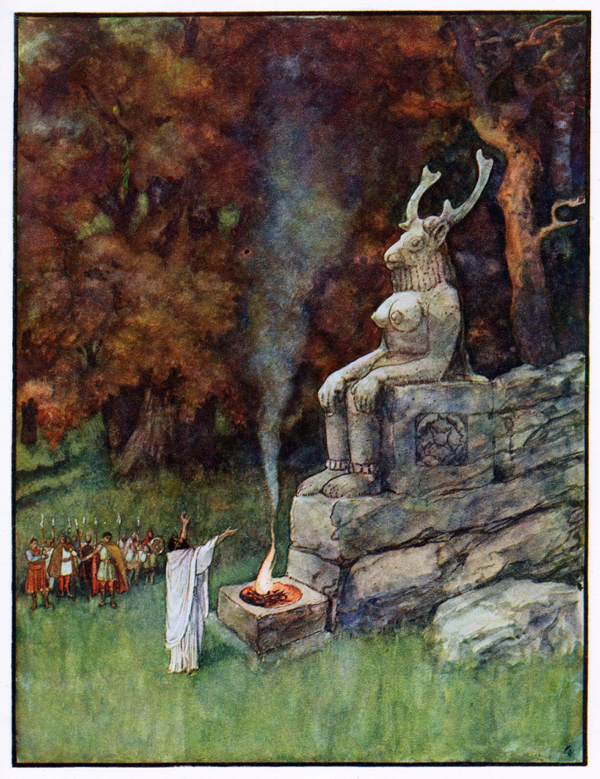 Illus. by Artuš Scheiner for Romance About The Faithful Friendship Of Amis And Amil,
a novel by Julius Zeyer
see the original flickr post by Josef Skrhola
Illus. by Artuš Scheiner for Romance About The Faithful Friendship Of Amis And Amil,
a novel by Julius Zeyer
see the original flickr post by Josef Skrhola
 Illus. by Artuš Scheiner for Romance About The Faithful Friendship Of Amis And Amil,
a novel by Julius Zeyer
see the original flickr post by Josef Skrhola
Illus. by Artuš Scheiner for Romance About The Faithful Friendship Of Amis And Amil,
a novel by Julius Zeyer
see the original flickr post by Josef Skrhola
 Illus. by Artuš Scheiner for Božená Němcová's Disobedient Kids...
see the original flickr post by Josef Skrhola
Caption: All at once, she saw little stars falling in her path way. She wanted to see what they looked like. They were yellow, bright and shining. She began to gather them up in her hands, tossing them up and down. "Oh, if I only had an apron!" Why there was an apron! Then she collected the little yellow stars in her apron, and growing very tired, fell asleep.
Illus. by Artuš Scheiner for Božená Němcová's Disobedient Kids...
see the original flickr post by Josef Skrhola
Caption: All at once, she saw little stars falling in her path way. She wanted to see what they looked like. They were yellow, bright and shining. She began to gather them up in her hands, tossing them up and down. "Oh, if I only had an apron!" Why there was an apron! Then she collected the little yellow stars in her apron, and growing very tired, fell asleep.
 Cover illus. by Artuš Scheiner for Božená Němcová's Disobedient Kids...
see the original flickr post by Josef Skrhola
Cover illus. by Artuš Scheiner for Božená Němcová's Disobedient Kids...
see the original flickr post by Josef Skrhola
 Illus by Artus Scheiner for Kulihrásek v hlubinách morskych /
Kulihrásek in the Depths of the Sea (1932)
via Cotsen Children's Library
Illus by Artus Scheiner for Kulihrásek v hlubinách morskych /
Kulihrásek in the Depths of the Sea (1932)
via Cotsen Children's Library
 Illus. by Artuš Scheiner for Vyšehrad by Julius Zeyer
see the original flickr post by Josef Skrhola
Illus. by Artuš Scheiner for Vyšehrad by Julius Zeyer
see the original flickr post by Josef Skrhola
 Illus. by Artuš Scheiner for Vyšehrad by Julius Zeyer
see the original flickr post by Josef Skrhola
Illus. by Artuš Scheiner for Vyšehrad by Julius Zeyer
see the original flickr post by Josef Skrhola
 Illus. by Artuš Scheiner for Vyšehrad by Julius Zeyer
see the original flickr post by Josef Skrhola
Illus. by Artuš Scheiner for Vyšehrad by Julius Zeyer
see the original flickr post by Josef Skrhola
 Illus. by Artuš Scheiner for Vyšehrad by Julius Zeyer
see the original flickr post by Josef Skrhola
Illus. by Artuš Scheiner for Vyšehrad by Julius Zeyer
see the original flickr post by Josef Skrhola
 Otesanek!
Illus. by Artuš Scheiner for Zlatovláska / Princess Goldie by Karel Jaromír Erben
see the original flickr post by Josef Skrhola
Otesanek!
Illus. by Artuš Scheiner for Zlatovláska / Princess Goldie by Karel Jaromír Erben
see the original flickr post by Josef Skrhola
 Illus. by Artuš Scheiner for Zlatovláska / Princess Goldie by Karel Jaromír Erben
see the original flickr post by Josef Skrhola
Illus. by Artuš Scheiner for Zlatovláska / Princess Goldie by Karel Jaromír Erben
see the original flickr post by Josef Skrhola
 Illus. by Artuš Scheiner for Zlatovláska / Princess Goldie by Karel Jaromír Erben
see the original flickr post by Josef Skrhola
Illus. by Artuš Scheiner for Zlatovláska / Princess Goldie by Karel Jaromír Erben
see the original flickr post by Josef Skrhola
 Illus. by Artuš Scheiner for Zlatovláska / Princess Goldie by Karel Jaromír Erben
see the original flickr post by Josef Skrhola
Illus. by Artuš Scheiner for Zlatovláska / Princess Goldie by Karel Jaromír Erben
see the original flickr post by Josef Skrhola
 Illus. by Artuš Scheiner for Fairy Tales Of Božena Němcová
see the original flickr post by Josef Skrhola
Illus. by Artuš Scheiner for Fairy Tales Of Božena Němcová
see the original flickr post by Josef Skrhola
 Illus. by Artuš Scheiner for Fairy Tales Of Božena Němcová
see the original flickr post by Josef Skrhola
Illus. by Artuš Scheiner for Fairy Tales Of Božena Němcová
see the original flickr post by Josef Skrhola
 Illus. by Artuš Scheiner for King Mouselet And Prince Youth - The Bold Dwarfs' Adventures (1905)
see the original flickr post by Josef Skrhola
Illus. by Artuš Scheiner for King Mouselet And Prince Youth - The Bold Dwarfs' Adventures (1905)
see the original flickr post by Josef Skrhola
 Wonderful decorations by Artuš Scheiner for King Mouselet And Prince Youth (1905)
see the original flickr post by Josef Skrhola
Wonderful decorations by Artuš Scheiner for King Mouselet And Prince Youth (1905)
see the original flickr post by Josef Skrhola
 Cover illus. by Artuš Scheiner for King Mouselet And Prince Youth by T. E. Tisovský
Cover illus. by Artuš Scheiner for King Mouselet And Prince Youth by T. E. Tisovský
 Cover illus. by Artuš Scheiner for Tales from Shakespeare (1923)
see the original flickr post by Josef Skrhola
See all posts tagged "Czech" on 50 Watts
Cover illus. by Artuš Scheiner for Tales from Shakespeare (1923)
see the original flickr post by Josef Skrhola
See all posts tagged "Czech" on 50 Watts
 Etienne Delessert, illustration for Stories 1, 2, 3, 4 by Ionesco
McSweeney's McMullens recently published—cause for celebration!—Stories 1, 2, 3, 4 by Eugene Ionesco and Etienne Delessert. (Get a copy from the publisher; Amazon.) The publisher explains: "Back in print for the first time since the 1970s, these illustrated stories by one of the twentieth century’s great playwrights make ideal bedtime reading for young children. The “silly” stories, as Ionesco called them, are accompanied by nearly 100 full-color illustrations. The art for Stories 1 & 2, first published in the 70s, was painstakingly restored by the artist. The art for stories 3 and 4 was newly made for this brand new "1234" compilation."
Etienne Delessert, illustration for Stories 1, 2, 3, 4 by Ionesco
McSweeney's McMullens recently published—cause for celebration!—Stories 1, 2, 3, 4 by Eugene Ionesco and Etienne Delessert. (Get a copy from the publisher; Amazon.) The publisher explains: "Back in print for the first time since the 1970s, these illustrated stories by one of the twentieth century’s great playwrights make ideal bedtime reading for young children. The “silly” stories, as Ionesco called them, are accompanied by nearly 100 full-color illustrations. The art for Stories 1 & 2, first published in the 70s, was painstakingly restored by the artist. The art for stories 3 and 4 was newly made for this brand new "1234" compilation."
 Etienne Delessert, illustration for Stories 1, 2, 3, 4 by Ionesco
Before getting to a short interview I did with Etienne Delessert (one of my favorite illustrators), I wanted to provide two fun sections from the book which I think could be published as stand-alone prose poems:
From Story #1"She had a mother who was named Mrs. Jacqueline. Her father was named Mr. Jacqueline. Little Jacqueline had two sisters who were both named Jacqueline, two boy cousins who were named Jacqueline, two girl cousins who were named Jacqueline, and an aunt and an uncle who were also named Jacqueline.
"The uncle and the aunt named Jacqueline had some friends named Mr. and Mrs. Jacqueline, who had a little girl named Jacqueline and a little boy named Jacqueline. The little girl had dolls, three dolls, named Jacqueline, Jacqueline, and Jacqueline."
From Story #2So Papa teaches Josette the real meaning of words. A chair is a window. The window is a fountain pen. A pillow is bread and bread is a bedside rug. Feet are ears, arms are feet. A head is a bottom. A bottom is a head. Eyes are fingers, fingers are eyes.
So Josette speaks the way her father teaches her. She says: "I look out the chair while eating my pillow, I open the wall, I walk with my ears. I have ten eyes to walk with and two fingers to look with. I put my head on the floor to sit down, I put my bottom on the ceiling. After eating the music box, I spread jam on the rug for a great dessert. Take the window, Papa, and draw me some pictures."
Etienne Delessert, illustration for Stories 1, 2, 3, 4 by Ionesco
Before getting to a short interview I did with Etienne Delessert (one of my favorite illustrators), I wanted to provide two fun sections from the book which I think could be published as stand-alone prose poems:
From Story #1"She had a mother who was named Mrs. Jacqueline. Her father was named Mr. Jacqueline. Little Jacqueline had two sisters who were both named Jacqueline, two boy cousins who were named Jacqueline, two girl cousins who were named Jacqueline, and an aunt and an uncle who were also named Jacqueline.
"The uncle and the aunt named Jacqueline had some friends named Mr. and Mrs. Jacqueline, who had a little girl named Jacqueline and a little boy named Jacqueline. The little girl had dolls, three dolls, named Jacqueline, Jacqueline, and Jacqueline."
From Story #2So Papa teaches Josette the real meaning of words. A chair is a window. The window is a fountain pen. A pillow is bread and bread is a bedside rug. Feet are ears, arms are feet. A head is a bottom. A bottom is a head. Eyes are fingers, fingers are eyes.
So Josette speaks the way her father teaches her. She says: "I look out the chair while eating my pillow, I open the wall, I walk with my ears. I have ten eyes to walk with and two fingers to look with. I put my head on the floor to sit down, I put my bottom on the ceiling. After eating the music box, I spread jam on the rug for a great dessert. Take the window, Papa, and draw me some pictures."
 Etienne Delessert, illustration for Stories 1, 2, 3, 4 by Ionesco
Q & A with Etienne Delessert
50 Watts: Had you followed Ionesco's work before illustrating his children's stories? Were you surprised he had written children's stories?Delessert: I was born with Kafka, Beckett and Ionesco for friends. I remember seeing Waiting for Godot when I was 17: it not only changed my vision of theatre, it changed my way to tell a story.
Had you illustrated the original French-language editions?
Long saga: the original Stories 1 and 2 were initially published in 1968 and 1970 in New York, where I was living then, by a small, quirky publishing house headed by Harlin Quist.
Quist had a really original talent, and gave lots of freedom to the artists he had chosen. But he was also an eminent crook, and Eugène Ionesco and I decided not to work on the next two stories as we realized that we would never be paid. It took me 40 years to go back to his texts and finish the book. It was a great challenge to draw the same characters, to stage similar stories such a long time after completing the two first ones. But it worked!
It had been my own idea to ask to Quist to contact Ionesco in Paris. He had never written for children.
Etienne Delessert, illustration for Stories 1, 2, 3, 4 by Ionesco
Q & A with Etienne Delessert
50 Watts: Had you followed Ionesco's work before illustrating his children's stories? Were you surprised he had written children's stories?Delessert: I was born with Kafka, Beckett and Ionesco for friends. I remember seeing Waiting for Godot when I was 17: it not only changed my vision of theatre, it changed my way to tell a story.
Had you illustrated the original French-language editions?
Long saga: the original Stories 1 and 2 were initially published in 1968 and 1970 in New York, where I was living then, by a small, quirky publishing house headed by Harlin Quist.
Quist had a really original talent, and gave lots of freedom to the artists he had chosen. But he was also an eminent crook, and Eugène Ionesco and I decided not to work on the next two stories as we realized that we would never be paid. It took me 40 years to go back to his texts and finish the book. It was a great challenge to draw the same characters, to stage similar stories such a long time after completing the two first ones. But it worked!
It had been my own idea to ask to Quist to contact Ionesco in Paris. He had never written for children.
 Etienne Delessert, illustration for Stories 1, 2, 3, 4 by Ionesco
Did you ever meet with Ionesco?We met after the first book came out, in New York. I remember going with him to see a doctor (he hated flying and needed pills to sleep on the plane) the day before he went back to France. From 42nd street to East 75th street we saw that day three cars burning, at three different locations: he was terrorized...
Later I met him several times at his place near La Coupole (in Story 3, I show part of his apartment). Years later he spent 10 days in Switzerland with me to prepare a long interview on film. Any reference to his plays would have been presented in animation. The film, produced by the Gallimard publishing house, was not completed. [Ed. note: Damn.]
Etienne Delessert, illustration for Stories 1, 2, 3, 4 by Ionesco
Did you ever meet with Ionesco?We met after the first book came out, in New York. I remember going with him to see a doctor (he hated flying and needed pills to sleep on the plane) the day before he went back to France. From 42nd street to East 75th street we saw that day three cars burning, at three different locations: he was terrorized...
Later I met him several times at his place near La Coupole (in Story 3, I show part of his apartment). Years later he spent 10 days in Switzerland with me to prepare a long interview on film. Any reference to his plays would have been presented in animation. The film, produced by the Gallimard publishing house, was not completed. [Ed. note: Damn.]
 Etienne Delessert, illustration for Stories 1, 2, 3, 4 by Ionesco
Did you get to discuss your illustrations with Ionesco, either before or after publication? No discussion before the books were published; at first he was surprised by my interpretations, then he understood that we were on the same wave length. The two books were very well received in seven languages, and reprinted often. But we never saw any royalties.
Instead of cleaning his act, Quist prefered to break our contract and ask two French artists to illustrate the two remaining texts. These mediocre interpretations disappeared quickly. So the Gallimard and McSweeney's editions are, finally, offering the original vision of the authors. We have five coeditions to date, including a large one in China.
Etienne Delessert, illustration for Stories 1, 2, 3, 4 by Ionesco
Did you get to discuss your illustrations with Ionesco, either before or after publication? No discussion before the books were published; at first he was surprised by my interpretations, then he understood that we were on the same wave length. The two books were very well received in seven languages, and reprinted often. But we never saw any royalties.
Instead of cleaning his act, Quist prefered to break our contract and ask two French artists to illustrate the two remaining texts. These mediocre interpretations disappeared quickly. So the Gallimard and McSweeney's editions are, finally, offering the original vision of the authors. We have five coeditions to date, including a large one in China.
 Etienne Delessert, illustration for Stories 1, 2, 3, 4 by Ionesco
How was the project received by readers and critics when first published?
I was amazed, 40 years later, to see the difference in the way some people perceived the stories. Back then we heard questions about what a real children's book should be. Same concern as for the Wild Things of Sendak.
But these are simple stories that a father is inventing for his daughter. And Ionesco was a very talented father... It was home theater and his daughter Marie-France had some fine lines too.
Thanks for taking the time to answer these questions, Etienne!
Etienne Delessert, illustration for Stories 1, 2, 3, 4 by Ionesco
How was the project received by readers and critics when first published?
I was amazed, 40 years later, to see the difference in the way some people perceived the stories. Back then we heard questions about what a real children's book should be. Same concern as for the Wild Things of Sendak.
But these are simple stories that a father is inventing for his daughter. And Ionesco was a very talented father... It was home theater and his daughter Marie-France had some fine lines too.
Thanks for taking the time to answer these questions, Etienne!
 Etienne Delessert, illustration for Stories 1, 2, 3, 4 by Ionesco
Bio of the illustrator:
Etienne Delessert was born in 1941 in Switzerland, and now lives in Lakeville, Connecticut, with his wife Rita Marshall and their son Adrien.
For more than thirty years this self-taught artist has been translating his—and the world's—ideas, passions, fantasies and nightmares into the visual language of books, magazine illustrations, posters, animated films, paintings and sculptures. He reaches both children and adults with his imaginary creatures and landscapes, juxtaposing the familiar with the fantastic to clarify this world and create new and lasting universes.
Delessert has illustrated more than eighty books, some translated in 14 languages, with millions of copies sold worldwide. From his groundbreaking The Endless Party, created in the 60's, along with his influential collaborations with Eugene Ionesco (Contes 1, 2, 3, 4) in French, and Jean Piaget (How The Mouse...), to his more recent award-winning A Long Long Song, Ashes Ashes, Dance!, The Seven Dwarfs, Who Killed Cock Robin?, Humpty Dumpty, Big and Bad, Full Color, Moon Theater and Spartacus the Spider. He is considered as one of the fathers of modern children's picture books.
Twice he was honored by the Premio Grafico of the Bologna World Children's Book Fair. His illustrations have appeared in leading magazines and newspapers such as The Atlantic Monthly, Le Monde and The New York Times. His animated films include the adventures of the endearing Yok-Yok and creations for Sesame Street.
He is the recipient of thirteen gold and twelve silver medals of the American Society of Illustrators as well as the 1996 Hamilton King Award, and recently a finalist for the 2010 Hans Christian Andersen Award.
Etienne Delessert, illustration for Stories 1, 2, 3, 4 by Ionesco
Bio of the illustrator:
Etienne Delessert was born in 1941 in Switzerland, and now lives in Lakeville, Connecticut, with his wife Rita Marshall and their son Adrien.
For more than thirty years this self-taught artist has been translating his—and the world's—ideas, passions, fantasies and nightmares into the visual language of books, magazine illustrations, posters, animated films, paintings and sculptures. He reaches both children and adults with his imaginary creatures and landscapes, juxtaposing the familiar with the fantastic to clarify this world and create new and lasting universes.
Delessert has illustrated more than eighty books, some translated in 14 languages, with millions of copies sold worldwide. From his groundbreaking The Endless Party, created in the 60's, along with his influential collaborations with Eugene Ionesco (Contes 1, 2, 3, 4) in French, and Jean Piaget (How The Mouse...), to his more recent award-winning A Long Long Song, Ashes Ashes, Dance!, The Seven Dwarfs, Who Killed Cock Robin?, Humpty Dumpty, Big and Bad, Full Color, Moon Theater and Spartacus the Spider. He is considered as one of the fathers of modern children's picture books.
Twice he was honored by the Premio Grafico of the Bologna World Children's Book Fair. His illustrations have appeared in leading magazines and newspapers such as The Atlantic Monthly, Le Monde and The New York Times. His animated films include the adventures of the endearing Yok-Yok and creations for Sesame Street.
He is the recipient of thirteen gold and twelve silver medals of the American Society of Illustrators as well as the 1996 Hamilton King Award, and recently a finalist for the 2010 Hans Christian Andersen Award.
 Etienne Delessert, illustration for Stories 1, 2, 3, 4 by Ionesco
Etienne Delessert, illustration for Stories 1, 2, 3, 4 by Ionesco
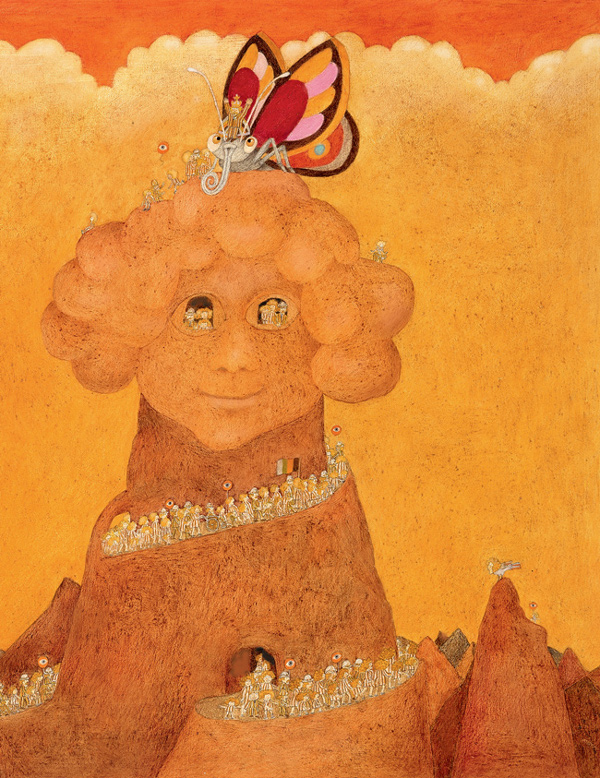 Etienne Delessert, illustration for Stories 1, 2, 3, 4 by Ionesco
Etienne Delessert, illustration for Stories 1, 2, 3, 4 by Ionesco
 Etienne Delessert, illustration for Stories 1, 2, 3, 4 by Ionesco
Etienne Delessert, illustration for Stories 1, 2, 3, 4 by Ionesco
 Etienne Delessert, illustration for Stories 1, 2, 3, 4 by Ionesco
Etienne Delessert, illustration for Stories 1, 2, 3, 4 by Ionesco
 Etienne Delessert, illustration for Stories 1, 2, 3, 4 by Ionesco
For more details about the publication history of this book, see a longer interview with Delessert on We Too Were Children.
But first buy the book!
Etienne Delessert, illustration for Stories 1, 2, 3, 4 by Ionesco
For more details about the publication history of this book, see a longer interview with Delessert on We Too Were Children.
But first buy the book!


 I featured this image in April 2009.
A Cotsen Children's Library exhibit says: "This is the caterpillar garden of Herr Hermelin, the ghostly white figure in the lower left-hand corner. He visits the pen every morning before breakfast, so he can admire their gorgeous coloration, stroke their backs, and make sure that each of his beauties is getting its favorite vegetation and is feeding well. Although the gaudy caterpillars look as if they must be products of the illustrator’s imagination, all of them are actually found in nature."
I featured this image in April 2009.
A Cotsen Children's Library exhibit says: "This is the caterpillar garden of Herr Hermelin, the ghostly white figure in the lower left-hand corner. He visits the pen every morning before breakfast, so he can admire their gorgeous coloration, stroke their backs, and make sure that each of his beauties is getting its favorite vegetation and is feeding well. Although the gaudy caterpillars look as if they must be products of the illustrator’s imagination, all of them are actually found in nature."








 From the Oxford Encyclopedia of Children's Literature: "One popular and frequently reproduced picture shows 'der Salomonssiegel' (Solomon's seal), a generous and mysterious plant who, while resembling his botanical namesake, appears as a sort of Green Man offering a gold chain to the flower fairies who seek him in Der Traumgarten.
From the Oxford Encyclopedia of Children's Literature: "One popular and frequently reproduced picture shows 'der Salomonssiegel' (Solomon's seal), a generous and mysterious plant who, while resembling his botanical namesake, appears as a sort of Green Man offering a gold chain to the flower fairies who seek him in Der Traumgarten.



 The dog is amazing here.
The dog is amazing here.


 Thank you Micky the Pixel for sharing this book. I previously featured his scans of Malbuchgeschichten.
I'm unclear on the publication history of these images. Micky's scans come from a 1955 Swiss edition. Cotsen gives 1924 as the estimated publication date of Sommervogel (source for its scan of the caterpillar herding image), though wikipedia give 1908 for that book. I have the feeling this issue of Der Traumgarten (first published as Der Gartentraum?!) pulls together various images from Sommervogel and Blumenmärchen. But really, who cares...
Green Tiger Press published a handful of Kreidolf's books in English in the US in the late 70s. The Dream Garden was one of them. (Amazon search results for "Kreidolf.")
From the Oxford Encyclopedia of Children's Literature:Ernst Kreidolf (1863–1956), German-born poet and illustrator. As a young man, Kreidolf studied lithography and later taught the craft. He left Germany for Switzerland during World War I. While he produced lifelike portraits, still-lifes (mostly of flowers), and a few religious pieces, he is best remembered for his more imaginative work. Kreidolf was fascinated with mythology, a subject on which he often spoke, and he originated his own myths around the spirits he saw in nature. In a style both spare and fantastic, he created a world in which every plant is animated and every garden inhabited by beneficent fairies.
With the juxtaposition of illustration and original rhyme, Kreidolf achieved great success in anthropomorphizing plants and revealing the magical side of nature.... in [Kreidolf's] world, nothing remains formless or inanimate. His pictures...communicate a sense of wonder about every aspect of the universe.
I've been collecting Kreidolf's books for three years, so more to come! (I really need to use my scanner more.)
See the full "Kinderbuch series" of German, Austrian, and Swiss children's books
See all children's books on 50 Watts
Thank you Micky the Pixel for sharing this book. I previously featured his scans of Malbuchgeschichten.
I'm unclear on the publication history of these images. Micky's scans come from a 1955 Swiss edition. Cotsen gives 1924 as the estimated publication date of Sommervogel (source for its scan of the caterpillar herding image), though wikipedia give 1908 for that book. I have the feeling this issue of Der Traumgarten (first published as Der Gartentraum?!) pulls together various images from Sommervogel and Blumenmärchen. But really, who cares...
Green Tiger Press published a handful of Kreidolf's books in English in the US in the late 70s. The Dream Garden was one of them. (Amazon search results for "Kreidolf.")
From the Oxford Encyclopedia of Children's Literature:Ernst Kreidolf (1863–1956), German-born poet and illustrator. As a young man, Kreidolf studied lithography and later taught the craft. He left Germany for Switzerland during World War I. While he produced lifelike portraits, still-lifes (mostly of flowers), and a few religious pieces, he is best remembered for his more imaginative work. Kreidolf was fascinated with mythology, a subject on which he often spoke, and he originated his own myths around the spirits he saw in nature. In a style both spare and fantastic, he created a world in which every plant is animated and every garden inhabited by beneficent fairies.
With the juxtaposition of illustration and original rhyme, Kreidolf achieved great success in anthropomorphizing plants and revealing the magical side of nature.... in [Kreidolf's] world, nothing remains formless or inanimate. His pictures...communicate a sense of wonder about every aspect of the universe.
I've been collecting Kreidolf's books for three years, so more to come! (I really need to use my scanner more.)
See the full "Kinderbuch series" of German, Austrian, and Swiss children's books
See all children's books on 50 Watts














 cover
cover
 This is my fourth post on Swedish illustrator Einar Nerman, with a few more in the works. (See them all here.)
From wikipediaEinar Nerman (6 October 1888, Norrköping – 1983) was a Swedish artist. He was born and grew up in middle class family in the working-class city of Norrköping and was the younger brother of the Swedish Communist leader Ture Nerman. Einar Nerman also had a twin brother, Birger Nerman, who was an archeologist.
Einar Nerman dropped out of his Norrköping Gymnasium High School in 1905 and moved to Stockholm to study art. In 1908 he moved to France for many years to pursue his interest in art, studying with Matisse at the Academie Matisse in Paris.
When he came back to Sweden in 1912 he started studying music and taking dance lessons. In the 1920s Nerman lived in London and drew images for The Tatler. During World War II, he lived and worked in New York.
Einar Nerman wrote songs and music and composed music and to many of his brother Ture Nerman’s poems.
Einar Nerman also made illustrations for many of the books by Selma Lagerlöf. In Sweden today, he is mostly known, or unknown, for being the man behind the art of the Solstickan matchbox. He also made some famous drawings of Greta Garbo, one of which was used on a postage stamp in 2005, a hundred years after the moviestar's birth.
A book of his drawings appeared in 1976: Caught in the Act (Harrap, London) with an introduction by his friend, lyricist Sandy Wilson. It contained many caricatures of friends in the London theatre world. From 1922 to 1930 he was the theatre cartoonist for The Tatler and also worked for the fashionable magazine Eve.
See all posts tagged "Sweden" on 50 Watts
This is my fourth post on Swedish illustrator Einar Nerman, with a few more in the works. (See them all here.)
From wikipediaEinar Nerman (6 October 1888, Norrköping – 1983) was a Swedish artist. He was born and grew up in middle class family in the working-class city of Norrköping and was the younger brother of the Swedish Communist leader Ture Nerman. Einar Nerman also had a twin brother, Birger Nerman, who was an archeologist.
Einar Nerman dropped out of his Norrköping Gymnasium High School in 1905 and moved to Stockholm to study art. In 1908 he moved to France for many years to pursue his interest in art, studying with Matisse at the Academie Matisse in Paris.
When he came back to Sweden in 1912 he started studying music and taking dance lessons. In the 1920s Nerman lived in London and drew images for The Tatler. During World War II, he lived and worked in New York.
Einar Nerman wrote songs and music and composed music and to many of his brother Ture Nerman’s poems.
Einar Nerman also made illustrations for many of the books by Selma Lagerlöf. In Sweden today, he is mostly known, or unknown, for being the man behind the art of the Solstickan matchbox. He also made some famous drawings of Greta Garbo, one of which was used on a postage stamp in 2005, a hundred years after the moviestar's birth.
A book of his drawings appeared in 1976: Caught in the Act (Harrap, London) with an introduction by his friend, lyricist Sandy Wilson. It contained many caricatures of friends in the London theatre world. From 1922 to 1930 he was the theatre cartoonist for The Tatler and also worked for the fashionable magazine Eve.
See all posts tagged "Sweden" on 50 Watts
 Details:
Details:
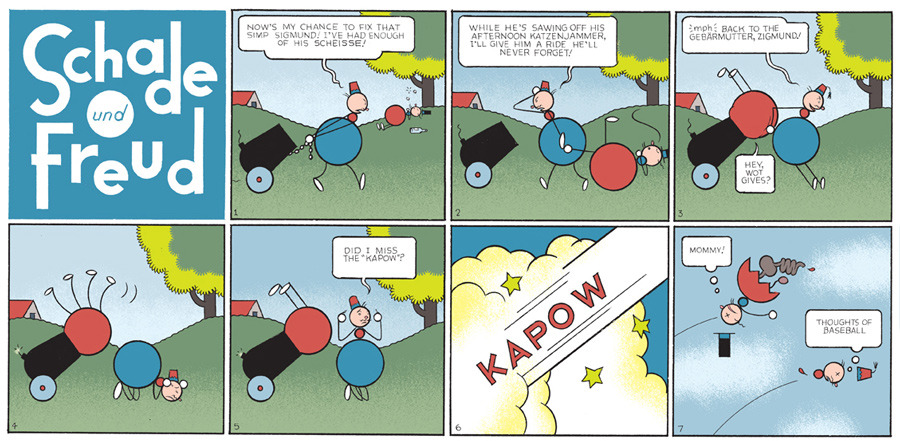
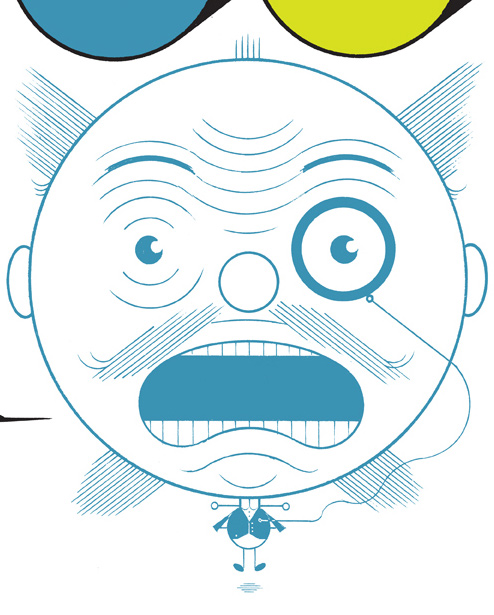
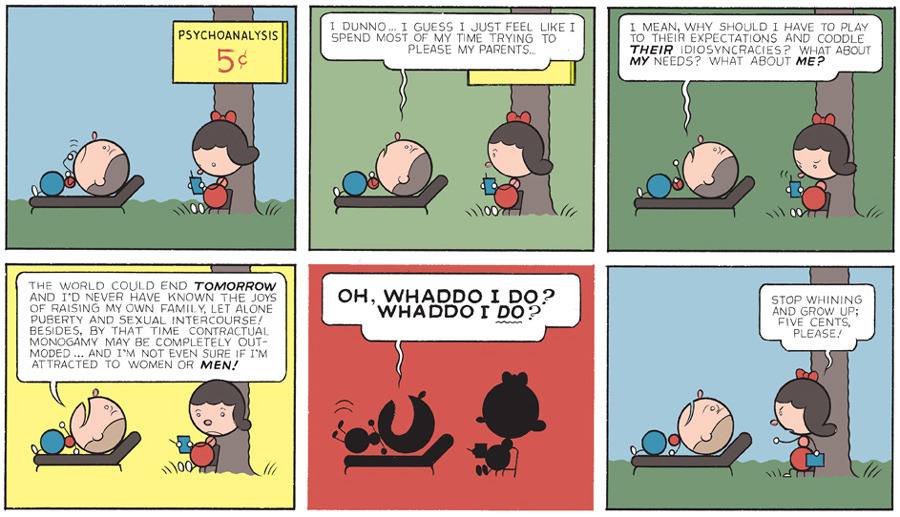
 50 Watts Comics filter (though surely there are more I haven't properly tagged)
50 Watts Comics filter (though surely there are more I haven't properly tagged)
 From Philip Oltermann's Rowohlt profile on New Books in German:Originally, RO-RO-RO stood for ‘Rowohlt Rotations Romane’: large-format novels printed on cheap newspaper stock and sold at no more than 50 pfennig apiece. In June 1950 their format shrank, as did the letters in the logo: Rowohlt published the first paperback novels on the German market. They were affordable – mainly because they would contain full-page ads for petrol, cars, perfume or cigarettes – and for many, rororos became the first books they could afford to buy with their pocket money. And yet they weren’t just pulp fiction. The first four rororos were by first-class writers of international renown: Hans Fallada, Graham Greene, Rudyard Kipling and Kurt Tucholsky. Rororo told the young Germany of the post-war generation good stories, but it also taught them something about the world.
The article is full of wonderful bits about Ernest Rowohlt and his authors (Kafka, Musil...Hemingway).
From Philip Oltermann's Rowohlt profile on New Books in German:Originally, RO-RO-RO stood for ‘Rowohlt Rotations Romane’: large-format novels printed on cheap newspaper stock and sold at no more than 50 pfennig apiece. In June 1950 their format shrank, as did the letters in the logo: Rowohlt published the first paperback novels on the German market. They were affordable – mainly because they would contain full-page ads for petrol, cars, perfume or cigarettes – and for many, rororos became the first books they could afford to buy with their pocket money. And yet they weren’t just pulp fiction. The first four rororos were by first-class writers of international renown: Hans Fallada, Graham Greene, Rudyard Kipling and Kurt Tucholsky. Rororo told the young Germany of the post-war generation good stories, but it also taught them something about the world.
The article is full of wonderful bits about Ernest Rowohlt and his authors (Kafka, Musil...Hemingway).




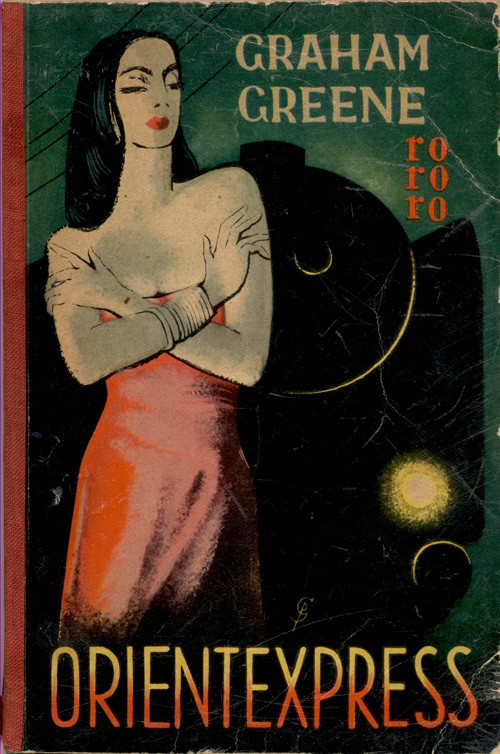 via uk vintage
via uk vintage
 via uk vintage
via uk vintage


 via Rauter25
via Rauter25
 via uk vintage
via uk vintage
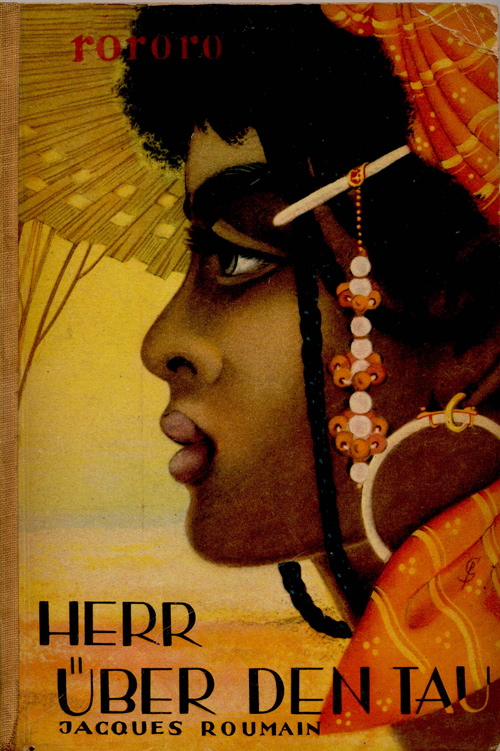 via uk vintage
via uk vintage


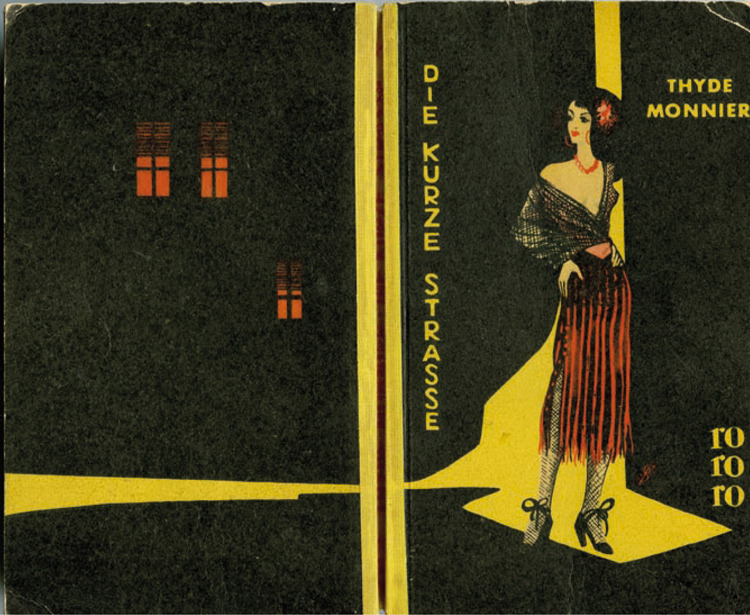

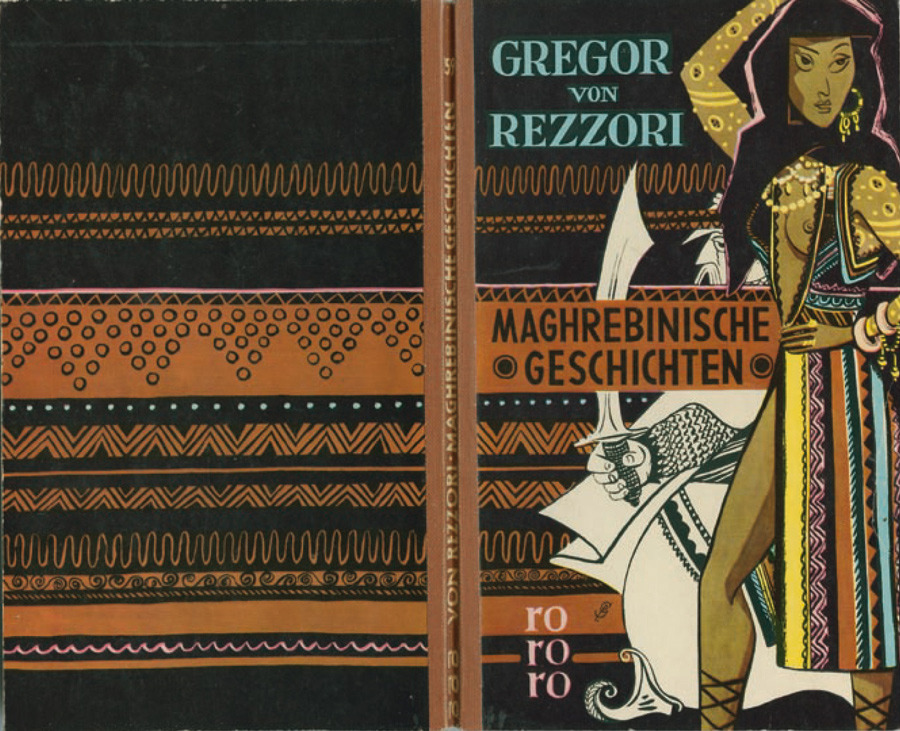
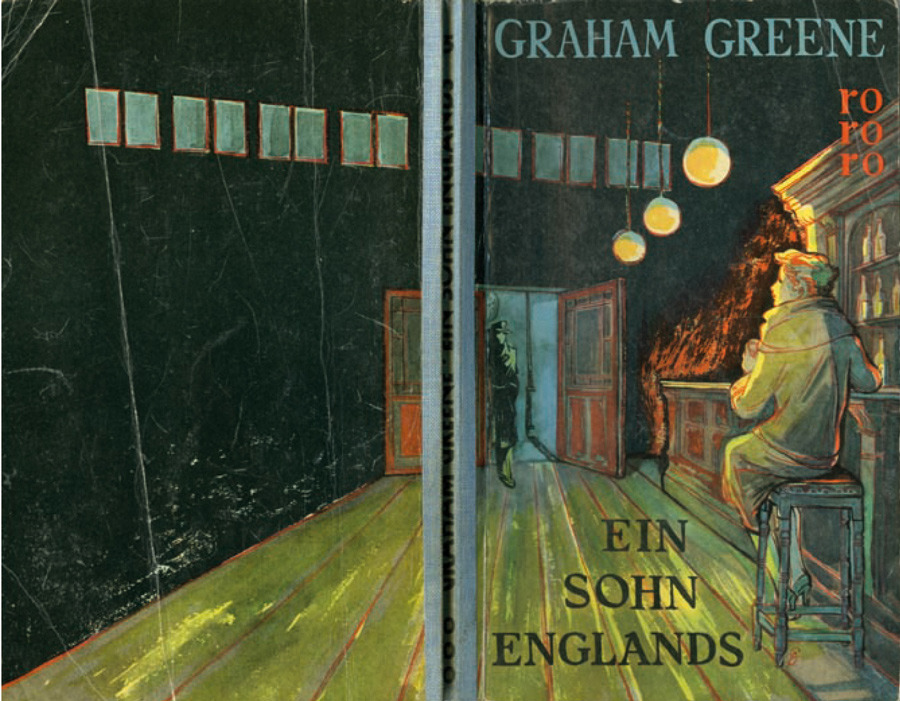

 via Bianca Schaalburg
via Bianca Schaalburg
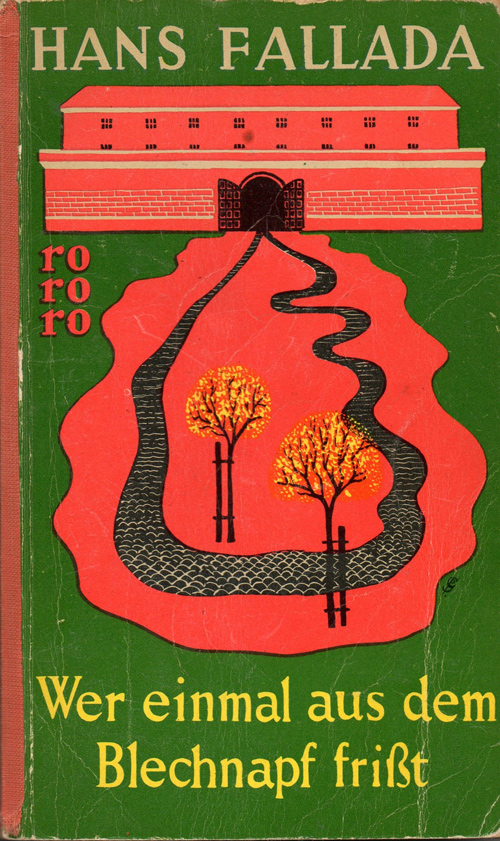 above & below via The Book Cover blog
above & below via The Book Cover blog
 Book covers on 50 Watts
Book covers on 50 Watts
 About the artist (from his website):Initially trained as a painter (BA from Trinity University in Studio Art and MA from Eastern Illinois University in Painting), Kreg Yingst turned his attention to the blockprint in the mid 1990’s after discovering the graphic novels of Lynd Ward and Frans Masereel. In 2003 he quit his teaching position to pursue a life-long dream of becoming a full-time artist. Two years later he founded Starving Artist Books as a means to help support orphanages and charities around the world.
He has illustrated numerous books, and his works can be seen in selected galleries and art fairs, as well as on-line at kregyingst.com
About the artist (from his website):Initially trained as a painter (BA from Trinity University in Studio Art and MA from Eastern Illinois University in Painting), Kreg Yingst turned his attention to the blockprint in the mid 1990’s after discovering the graphic novels of Lynd Ward and Frans Masereel. In 2003 he quit his teaching position to pursue a life-long dream of becoming a full-time artist. Two years later he founded Starving Artist Books as a means to help support orphanages and charities around the world.
He has illustrated numerous books, and his works can be seen in selected galleries and art fairs, as well as on-line at kregyingst.com










 See all posts from the collection of Richard Sica
See all posts from the collection of Richard Sica
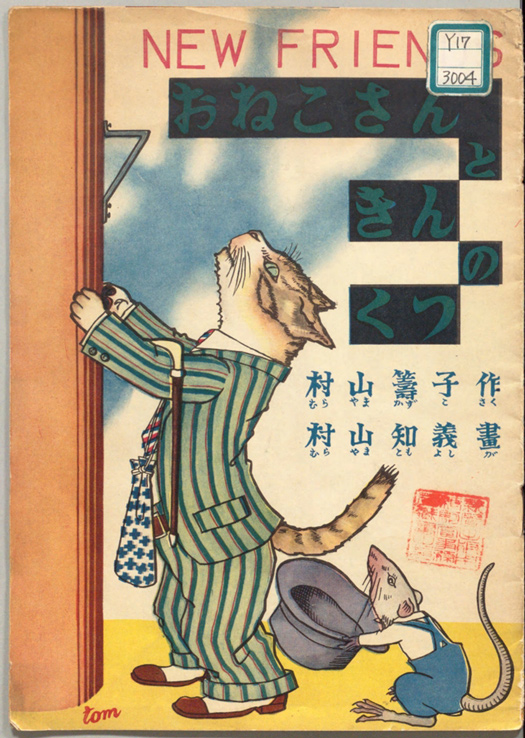 Google translates the Japanese title — おねこさんときんのくつ — as "Your cat's shoes and money"...but since the cover says "New Friends" let's just call it that. (My cut-and-paste notes for this book also include the cryptic line, "Santo cat shoes off fungus.")
The scans come from Japan's National Diet Library.
Murayama Tomoyoshi (1901–77) is a fascinating figure: a popular children's book illustrator as well as a participant in the 1920s radical art group MAVO. Read about him in frieze and on wikipedia. That Tom wound up in Berlin in 1922 makes me think his life must have been a wild ride.
I initially found Tom through his work for Kodomo no Kuni and similar publications. He's responsible for the first image in my previous post of Japanese book covers.
Google translates the Japanese title — おねこさんときんのくつ — as "Your cat's shoes and money"...but since the cover says "New Friends" let's just call it that. (My cut-and-paste notes for this book also include the cryptic line, "Santo cat shoes off fungus.")
The scans come from Japan's National Diet Library.
Murayama Tomoyoshi (1901–77) is a fascinating figure: a popular children's book illustrator as well as a participant in the 1920s radical art group MAVO. Read about him in frieze and on wikipedia. That Tom wound up in Berlin in 1922 makes me think his life must have been a wild ride.
I initially found Tom through his work for Kodomo no Kuni and similar publications. He's responsible for the first image in my previous post of Japanese book covers.



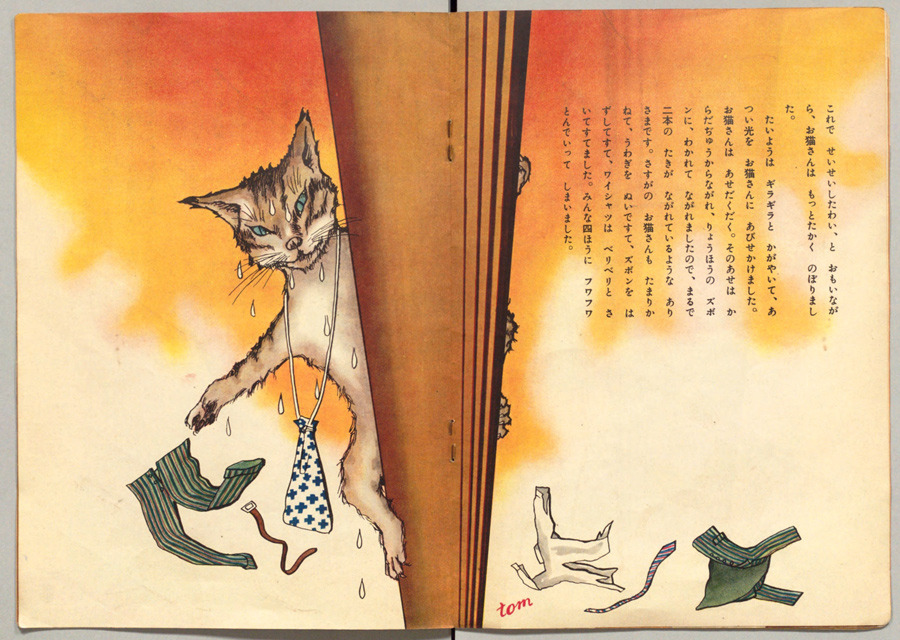
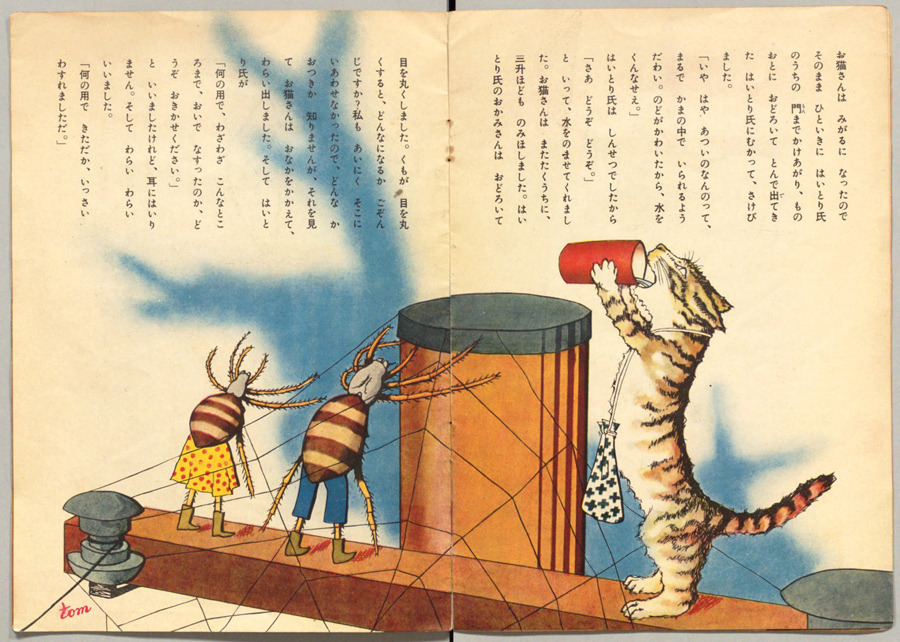


 Previous posts on Japan
Previous posts on Japan